2023-2024











“This budget will raise more revenue from property taxes than last year's budget by an amount of $9,535,166, which is a 42.00 percent increase from last year's budget. The property tax revenue to be raised from new property added to the tax roll this year is $5,603,248.”
The above information is presented on the cover page of the City of Celina’s FY2024 Adopted Budget to comply with requirements of Section 102.007(d) of the Texas Local Government Code.



The members of the governing body voted on the adoption of the budget as follows: FOR:
Philip Ferguson, Place 1
Andy Hopkins, Place 3
Mindy Koehne, Place 5
AGAINST:
Jay Pierce, Place 2
Wendie Wigginton, Place 4
Tony Griggs, Place 6
PRESENT and not voting: Ryan Tubbs, Mayor
ABSENT:
The total amount of municipal debt obligations secured by property taxes for the City of Celina is $355,130,000.

The 86th Legislature passed HB 1495 to increase the transparency of local government lobbying. In accordance with Section 104.0045 of the Texas Local Government Code as amended by HB 1495 – Itemization of Certain Expenditures Required in Certain Political Subdivision Budgets‐ expense line items for public notices and lobbying efforts are provided below:


City Manager’s Office:
Karla Stovall, Interim City Manager
Kimberly Brawner, Assistant City Manager
Prepared By:
Robin Bromiley, MSA, CGFO, Director of Finance
Dan Galizia, CGFO, Budget Manager
A special thanks to the Marketing Department for the cover, Strategic Services for the Strategic Plan, the City Manager’s Office for review and support, and all departments for their hard work preparing the budget.










Current:

Celina is literally wired for connectivity with high‐speed fiber but also encourages personal connections through interconnected trails, open patios, and a thriving City square. Businesses and communities are built on these connections.
Celina brings people together.
Business Spotlight videos are produced, to introduce Celina's small businesses to our community, providing free advertisement opportunities on our Youtube channel and in the monthly Life Connected newsletter
LIFEINCELINATX.COM
Our lifestyle website features sections for Live, Work, Play and Learn activities around Celina.
The official community podcast of Celina. On every episode, we celebrate and share the stories behind the amazing people, businesses, and groups that make Celina Home.
• We do the right thing at all times
• We are committed to building and maintaining credibility and trust both internally and externally
• We are accountable in our words and actions
• We question that which may be inconsistent with our Core Values
• We are a unified body and work as a team
• When we disagree, we resolve it according to our Core Values
• We value and respect all employees and our customers
• We foster a culture that includes understanding, support, balance and a sense of humor
• We embrace openness, diversity and inclusion
• We always do our best
• We embrace innovation and efficiency while remaining good stewards of City resources
• We are accountable and take pride in our work
• We seek opportunities to learn and expand our professional horizons
• We are selfless public servants and believe in helping other
• We treat everyone the way we wish to be treated
• We are caring and empathetic in all we do
• We work to deliver excellent service to all we encounter


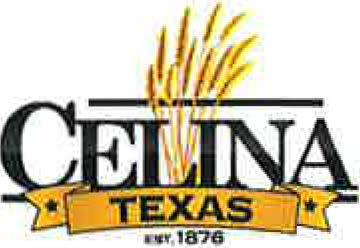
July 31, 2023
Honorable Mayor and Members of the City Council:
I am very pleased to present the Adopted Fiscal Year 2023‐2024 (FY 24) Budget for the City of Celina for your review. This budget, which begins October 1, 2023, is given to you in accordance with the laws of the State of Texas and the City of Celina Charter. The adopted 2023‐2024 budget, as presented, is balanced for all funds and grants the opportunity to continue providing an exceptional array of services to the residents of Celina and those who visit here. The provisions within this budget are based on the guiding principles established and confirmed in the City’s Strategic Plan, Comprehensive Plan, and Core Values.
As we look toward the endless possibilities for the City of Celina in the upcoming fiscal year, it helps to recall the successes we enjoyed and the strides we made during the previous fiscal year. Ever since the Dallas Business Journal recognized Celina as the Fastest Growing City in North Texas (based on population growth from 2016‐2020), we have continued to experience high growth on every front.

With unprecedented population expansion, the ability to provide adequate public safety to our residents is essential and remains a highest priority. Construction of the Law Enforcement Center on Coit Road and Fire Station #3 on FM 1385 are well underway, and sites for future police and fire stations have been purchased and carefully planned so that these critical services stay ahead of the growth. Another imperative component for a growing City is healthcare. Methodist Health System is now building its $200 million hospital campus at the corner of Dallas North Tollway and FM 428, and Scottish Rite for Children is designing a facility for their 76 acres of land near the intersection of Dallas Parkway and Punk Carter Parkway. With the opening of the Dallas Parkway expansion (future Dallas North Tollway) to the Collin/Grayson County line, this area is quickly becoming the newest healthcare corridor in North Texas.
Over the past year, the retail giants Costco and HEB have made significant land acquisitions, setting off a burst of commercial development activities along Preston Road. The announcement of their presence has sparked great interest from national chains. This activity has undoubtedly reshaped the retail landscape of Celina. Despite the emergence of these major players, the cherished small business community remains a vibrant and integral part of life in Celina. The Forge 1912, Mangiamo’s Italian Market, and The Wick, will be among the newest additions to our Downtown. As commercial development progresses, numerous businesses are opening nearby, including Browning Showroom and A1 Locksmith, Legacy Bagels, Swig, 7Eleven, and The
Silos, among others. Notably, the community's commitment to supporting local entrepreneurs hasn't wavered, and there is a welcoming atmosphere for even more businesses to thrive.
Our younger residents and their educators experienced greater opportunities to excel with the opening of Celina I.S.D.’s new Moore Middle School that welcomed students last Fall. The new Martin Elementary School is slated to open in August. Also, a benefit from the cherished relationship between Celina and our schools, construction recently began at the historic Bobcat Field Complex for our new Ralph O’Dell Senior Center. This amenity will be the first of several projects at the crown of the upcoming linear park to be built along Doe Branch.
Critical infrastructure projects continued in Downtown and throughout the City, per the Strategic Plan that was initially adopted by the City in May 2022. Much needed roadways, such as the Frontier Parkway expansion and desperately needed changes to Parvin Road continue. Necessary downtown drainage and parking solutions will afford downtown residents and guests some of the finest upgrades since the square was built in 1911. By adhering to the recently updated Strategic Plan, the City can focus fiscal decisions on actionable items that will impact our residents and visitors all over this community for generations to come.
The Budget Overview, City Fund Summary, and Fund Budgets that follow this letter will provide an overview of revenue and expenditure budgets for FY 2024 and the financial impact comparison to the previous fiscal year.
The same true spirit of Celina that pioneered our past will, undoubtedly, forge our future. This document ensures that every decision about the City be made through the lens of rightful actions, honesty, transparency, and mindfulness for our future success. We are leading a great City and will continue to achieve great things, together, in FY 2024.

Respectfully submitted, Karla
Karla Stovall Interim City ManagerOur mission is to preserve our agricultural heritage and flourish as a close‐knit, ever‐growing Celina family during the explosive and planned growth of our City. We will provide a unique and extraordinary quality of life complemented by a significant array of high‐tech and desirable businesses, agritourism assets, unique destinations, and connections.
1. Be the Life Connected. City
Living a Life Connected. is not just our tagline, it's our mission that extends into every decision made. Life Connected. touches on the social and physical aspects of connectivity. Objectives within this Strategic Plan goal touch upon quality of life enhancements that aim to keep residents invested long‐term.
2. Be the Unique City
Celina is known for its small town charm, and nothing exhibits this better than our historic Downtown. This Strategic Plan goal seeks to preserve Celina's unique heritage through fortifying and expanding Downtown. Celina carries these unique attributes to other planning efforts around the City and infusing its agricultural past into City projects. Furthermore, this Strategic Plan goal seeks to embrace future residents through tradition and heritage efforts that share our story.
3. Be the City of the Future, Connected to its Past
How does Celina maintain its unique qualities while experiencing exponential population growth? This Strategic Plan goal seeks to connect current and future residents to Celina's unique past. Objectives in this Strategic Plan goal include recommending future projects that reflect Celina's unique culture.

4. Be the City Built on Public Safety
Safety and security are two of the most basic human needs, and one of the biggest drivers of quality of life in cities. Public safety and emergency services are a strength, and we intend to fortify them.
5. Be the City of Servant Leaders
This goal speaks to our organizational culture to attract and retain the right employees in the right role, who are motivated to serve the community. The philosophy of Servant Leadership puts the needs and growth of others first.
6. Be the City of Innovative Infrastructure
Infrastructure innovation is a necessity in a high‐growth city. With limited resources and a high demand for new infrastructure, a creative approach is required when addressing funding mechanisms. This Strategic Plan goal speaks to adopting innovative infrastructure policies and projects that ensures a sustainable path for growth.
7. Be the City of
Small business is one of our biggest strengths and opportunities. It represents the heart of our community, and we recognize its importance to our quality of life and economic development. Objectives in this Strategic Plan goal include adopting policies, codes, and ordinances that cultivate the right environment for small businesses to thrive.

As a City, we want to share our story through what we say, what we publish, the improvements we construct, and the things we do. We want to share what we are working on, the great things happening, and who we are as a City. By infusing these communication strategies through each Strategic Plan goal, we will successfully communicate the stories, efforts, events, and information that matters to residents.

The annual operating budget for the City of Celina is the conclusion of many hours of work that continues through the year until the adoption of both the tax rate and proposed budget in September. The City Manager, Executive Team, department directors, and staff work together throughout the budget process regarding priorities by placing the needs of the community first and in line with the City Council’s strategic plan and core values. A biennial citizen survey is conducted and used to update the strategic plan. Celina’s core values are the foundation of the organization for which the departmental budgets are built and are as follows:
Be Service focused
Place the Community first
Make ethical (Integrity) decisions
Maximize efficiency through Excellence
The City of Celina’s internal core value system stems from the philosophy of Servant Leadership and the belief that as public servants, all actions stem from the obligation to put the needs of the residents first and dedicate our decision making and actions to the ideal that City employees exist to serve the people. These Core Values represent our highest aspirations, our moral code, and what we are deeply passionate about.
All of this in tandem embodies “Life Connected.” making a genuine connection from the City to all residents and businesses. Living “Life Connected.” is how we as the City, bring life to our core values; ensuring every decision about the City is made through the lens of rightful actions, honesty, transparency, and mindfulness for our future success. These citizen surveys, strategic plans, and core values are designed to work in conjunction and are designed to serve as the foundation for each annual budget.
The City of Celina’s mission is to preserve our agricultural heritage and flourish as a close‐knit, ever‐growing Celina family during the explosive and planned growth of our City. We will provide a unique and extraordinary quality of life complemented by a significant array of high‐tech and desirable businesses, agritourism assets, unique destinations, and connections. In March 2023, to accomplish this mission, the City Council adopted its updated 2023‐2025 Strategic Plan.

The eight strategic plan goals for 2023‐2025 are:
Be the Life Connected. City
Be the Unique City
Be the City of the Future, Connected to its Past
Be the City Built on Public Safety
Be the City of Servant Leaders
Be the City of Innovative Infrastructure
Be the City of Small Business
Be the City that Shares Our Story
By adhering to the Strategic Plan, the City will focus fiscal decisions on actionable items that will impact the City.
In April 2021, the Celina 2040 Comprehensive Plan was implemented. The Comprehensive Plan provides a framework for sustainable fiscal decisions to ensure the community vitality over time. Every financial decision made by the City will use this framework to ensure that each initiative will adhere to the needs of the residents.
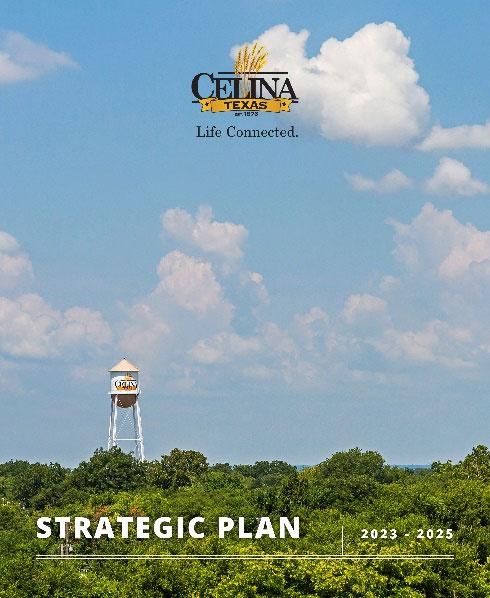



The City Manager and Executive Team review all budget requests for alignment with Council direction with reference to the City’s Strategic and Comprehensive Plans. Collectively, these plans outline a path that will ensure that Celina maintains its rural and welcoming feel while facilitating new development and improvements in the right way.

Budget Planning
January
Adopted Budget
October
City Council’s Budget
August & September
DepartmentBudgets
February to April City Manager’s Proposed Budget
June & July
The annual budget process begins in January each year. The budget calendar outlining key dates for the upcoming budget year as well as the budget manual outlining the important components that each department is responsible for is provided. The City of Celina utilizes a budget planning software provided by McLain Decision Support Systems called mBudget to help develop the upcoming year’s budget and future planning years. The software provides the detail budget and helps directors to complete their end of year forecasts along with capital requests, new service level requests and new staffing request for the new fiscal year. In February, mBudget is opened for directors to begin formulating their budgets.
In January and February, the City Council work on an annual strategic plan and strategic goal update. The direction given by the strategic plan drives the budget process forward by providing goals and direction.
The Strategic Plan in Envisio Software is reviewed and updated monthly to review and update objectives to track our progress. This monthly update serves as a reminder to department directors and the executive team of the vision that City Council has identified for the upcoming fiscal year.
In March and April, Finance provides up‐to‐date information and helps to answer questions as departments begin finalizing their budget requests. In April, preliminary budgets are submitted for review by the Executive Team. After budgets have been submitted, Finance completes a review of all revenues and expenditures for the new year and will adjust as needed. This process is completed by the end of May each year.
Budget Workshop with the Executive Team and each department is held in June. During workshop the financial position of the City is discussed as well as budget priorities for the upcoming year. Base budgets, capital and new staff requests for each department are assessed and adjustments are made in order to balance the budget. This workshop lends itself to each member of the executive team with the City Manager to take ownership of the City’s overall budget.
Certified appraisals from both Collin and Denton Counties are submitted at the end of July and Finance formulates a final proposed operating budget that is balanced and is in conformity with the City’s fund balance requirements.

At the beginning of August, the City Manager presents a proposed budget to the City Council in council workshop. In September, public hearings are held for the proposed budget and proposed tax rate to gather public feedback. The last step is the formal adoption of the tax rate and budget by ordinance during the September council meeting. Once adopted, the tax rate and budget go into effect October 1st for the start of the new fiscal year.
Budget modifications after adoption are done via budget transfer by the Finance Department to reallocate budget authority within a fund or authorized by City Council with a Budget Amendment to increase or decrease the budget authority of a fund.
Citizens are encouraged to be involved in the budget process. The FY 2024 budget is brought before City Council on three occasions. The first is the City Manager’s Proposed Budget Workshop on July 31st During this special meeting the City Manager’s Proposed Budget is presented to City Council in detail. The second is at the regular City Council Meeting in August where the no‐new‐
revenue and voter‐approved tax rates are submitted to City Council. The third is at the regular City Council meeting in September when the tax rates and budget are adopted after a public hearing.
The City of Celina conducted Citizen Surveys in 2018, 2020, and 2022 to gauge the level of satisfaction with City services and identify areas for improvement. The areas identified for greatest improvement are the roads, water and sewer services, and providing parks and recreation opportunities.
Celina residents experience a high quality of life.

The economy is healthy in Celina, though residents point to the following areas for possible improvement.
o Downtown Development
o Professional Services
o Shopping Opportunities
o Transportation and Parking
o Culture and Arts
Parks and Recreation is an area of opportunity specifically to:
o Recreation Centers or Facilities
o Recreational Opportunities
o Walking paths and trails
o Fitness opportunities
Safety is an asset in Celina.


Celina has established a reputation for having high development standards that has drawn businesses and families to the area. This rapid and smart growth of the city brings forth certain unique characteristics that set it apart from other cities. At present, the primary source of revenue for the General Fund comes from building permit fees, followed by property taxes and sales taxes. As the City continues to expand, meeting the demands of its growing population necessitates the addition of staff each fiscal year. (Further details regarding Full‐Time Equivalents

‐ FTE ‐ is discussed later in the Budget Overview.)
In response to the increasing demands of the population, Celina is actively engaged in designing, constructing, and planning numerous Capital Improvement projects. These projects encompass various areas, such as streets, parks, administrative buildings, water distribution systems, and wastewater treatment enhancements. These investments in infrastructure aim to support the City's growth and provide enhanced facilities and services to its residents and businesses for years to come.
The Combined Budget Summary is inclusive of the General Operating funds, Enterprise funds, Special Revenues funds, Governmental funds, Capital Improvements funds, and Component Units. The total adopted appropriations budget for all funds including the Capital Improvement Project funds and component units is $195.52 million for FY 2023‐24 and the total adopted revenues budget for all funding is $135.0 million.
The Combined Budget Summary is in the section entitled City Fund Summary and shows a detailed look at revenues and expenditures by category. Each fund identified on this schedule shows beginning balances, revenues, and expenditures. Revenues are broken down by type and expenditures are broken down by category including General Government, Public Safety, Development Services and Engineering, Recreation and Culture, Public Services, Utilities, Debt Services, and Transfers Out.
The City of Celina utilizes a fiscally conservative strategy when projecting revenues and expenditures. Revenue and expenditure patterns are closely monitored so that adjustments can be made readily throughout the year with amendments going before the City Council for approval.
The City of Celina takes a stable approach when projecting revenues. Residential and commercial growth, along with economic expectations, are primary drivers in estimating revenues. In the past several years, the City of Celina has enjoyed a relatively stable upward revenue trend. This trend is caused by growth in population, property values, sales tax, and the development of residential communities. While monitoring changes in building permit fee revenues, the City still anticipates residential growth during the next several years, focus on the revenue structure for the future will shift more towards sales tax growth with commercial business.
The City of Celina is striving to diversify its revenues, expand the City tax base through economic expansion, maintain healthy financial reserves and hire and retain a top‐quality workforce. The City strives to deliver services in a customer friendly, pro‐business and pro‐development manner.
The major Sources of revenue for the City of Celina are Ad Valorem Taxes, Sales Taxes, Licenses and Permits, and Rates, Fees, and Charges.

All sources of funding with the exception for the Capital Improvement Project fund (CIP) planned for FY 2023‐24 is $131.00 million an increase over the adopted FY 2022‐23 revenue budget by $38.92 million or 42.26%.
Ad Valorem or property tax is a major revenue source for the City. It provides revenue for general government operations, debt payments, and TIRZ funds. This year, $33,778,486 has been budgeted for all property tax collections including delinquents, penalties, and for payments to the tax increment reinvestment zones (TIRZ).
Sales tax revenue for all funds is expected to grow 5.35% over last year. A budget of $7.41 million has been forecast for the upcoming year across all funds. Celina has enjoyed continued sales tax growth year over year. The original adopted sales tax budget for FY 2021‐22 was $4.37 million and FY 2022‐23 was $7.03 million. Sales tax revenue is net of all sales tax rebates and contractual agreements.

Rates, fees, and charges for service is the main source of revenue for the City and was adopted in FY 2024 at $58.58 million and represents about 44.72% of the City’s revenue. The increase in rates, fees, and charges over FY 2023 is $14.24 million or about 32.10% and is largely attributed to growth in population resulting in increased use of services in the utilities.
A percentage of the adopted city‐wide rates, fees and charges for service are budgeted for water and wastewater services representing $34.57 million or 59.02% of the $58.58 million adopted for FY 2024. Of the water and wastewater $34.57 million, $17.27 million or 29.48% comes from water sales, $10.20 million or 17.41% for wastewater sales, $5.51 million or 9.41% from water/wastewater connection fees, and an additional $1.59 million or 2.72% from other services including meter and developer revenue.
In June 2022, the City created a new Enterprise fund from the Water/Wastewater Fund called the Solid Waste Fund. All revenues and expenditures for sales and services that were held in the Water/Wastewater Fund were transferred into the Solid Waste Fund. The Solid Waste Fund provides for the collection of solid waste and disposal along with recycling services and maintaining of the public rights‐of‐way in the City. Rates and fees for services were adopted at $3,385,000 for the upcoming year. Other taxes and interest add $280,000 to the total revenue for Solid Waste to $3,665,000 Operational costs for contracted garbage and recycling services and maintaining of the rights‐of way is budgeted at $3,110,000.
Another major source of revenue originates from Licenses and Permits. These revenues are generated for services rendered and user fees charged for permits, construction inspection fees, fire/EMS and police fees, and other related services. Revenue of $12,575,000 was adopted for FY 2023‐24 which is an increase of $2.55 million over the adopted FY 2022‐23 budget.
Interest income is budgeted to increase by $4.68 million or 802.08%. This is primarily due to recent debt issuances coincided with increased interest rates.
Transfers In are a part of the total sources of funds and were adopted at $8,409,626. This number reflects one‐time transfers for infrastructure improvements and reimbursement of in‐kind services across the funds. The remaining revenue is attributable to other types of services and interest income. The transfers also include the funding for the vehicle equipment replacement funds for both the General Fund and the Water/Wastewater Fund.
Property taxes are a revenue source for the General Fund and Debt Service Fund. Property taxes are the second largest revenue source of the City, behind rates, fees, and charges for services. They are largely considered a stable and inelastic revenue source.
According to the Collin and Denton Central Appraisal Districts, the certified taxable value after the homesteads with tax ceiling is estimated with appraisal review board (ARB) approved is $5,897,434,904. This value is 42.5% or $1.760 billion more in assessed valuation than tax year 2022 adjusted taxable value (as of 07/20/2023). Of this increase, $847 million is attributable to new taxable values added to the tax roll which includes improvements and personal property.

The City will strive to maintain a tax rate that keeps level with other cities and towns while still providing adequate revenue to fund the needs of a rapidly growing community now and into the future. As the City grows so will the demands for service, the tax revenue will also need to increase due to the growing population and rooftops. This year, the City has adopted a tax rate of $0.612154 to meet these objectives.
The adopted tax rate of $0.612154, is a tax rate reduction from the FY 2022‐23 tax rate of $.634759. Of the total tax rate of $0.612154, $0.315878 or 51.60% is dedicated to maintenance and operation expenses of the municipal government and $0.296276 or 48.40% is dedicated to general obligation debt service.

The average taxable single‐family home value is $512,151 as of July 2023. At a property tax rate of $0.612154, the City tax paid on the average single‐family home will be approximately $3,135. For comparison purposes, a single‐family home valued at $100,000 will pay $612.

Historical picture of the City’s tax rate history for maintenance & operations and interest & sinking.
In the past, local governing bodies have had the autonomy to realize up to 8% of revenue growth from property taxes at their discretion. However, in 2021 Senate Bill 2 – Texas Property Tax Reform and Transparency Act from the 86th legislative session was implemented. Senate Bill 2 caps tax rate calculations and revenue growth at 3.5%. New taxable property added to the tax rolls is not included in the 3.5% cap. Citizens may vote to increase revenues above the 3.5% cap.

Celina’s conservative revenue forecasts will help mitigate any negative impacts of the revenue cap to the City’s operations; however, the City will have to pay close attention to revenue numbers in future years and determine when an election is necessary to keep up with demands for service and growth.

Over the past five years, Celina has situated itself among the top cities in terms of smart growth. By focusing on high standards and master planning, Celina residents can rest assured that they live in a unique and beautiful community. Celina has established a presence in North Texas and has now gained the attention of commercial developers. Sales tax revenue will continue to increase as commercial development begins matching the pace of Celina’s population growth.

The sales tax rate for the City is 2.0% of which, half is allocated to the General Fund (1%), a quarter allocated to the Community Development Corporation (CDC) (0.5%), and a quarter is allocated to the Economic Development Corporation (EDC) (0.5%).
In October 2019, the State of Texas implemented a new regulation mandating online retailers to levy an 8.0% sales tax on sales made through online marketplaces. This change had a notable effect during the pandemic, as it led to an increase in revenue generated from sales tax for Celina. Unlike many other cities, Celina experienced a unique situation during the pandemic where the City did not suffer a decline in sales tax revenues due to the closure of big box retailers and commercial establishments. The reason behind this was the City's ability to collect sales tax from online sales without facing the negative impact of failing businesses. With new regulation and the continued addition of many new businesses, the City has experienced rapid growth in sales tax revenues. The charts below depicts City wide sales tax revenue that is net of any incentive agreements.

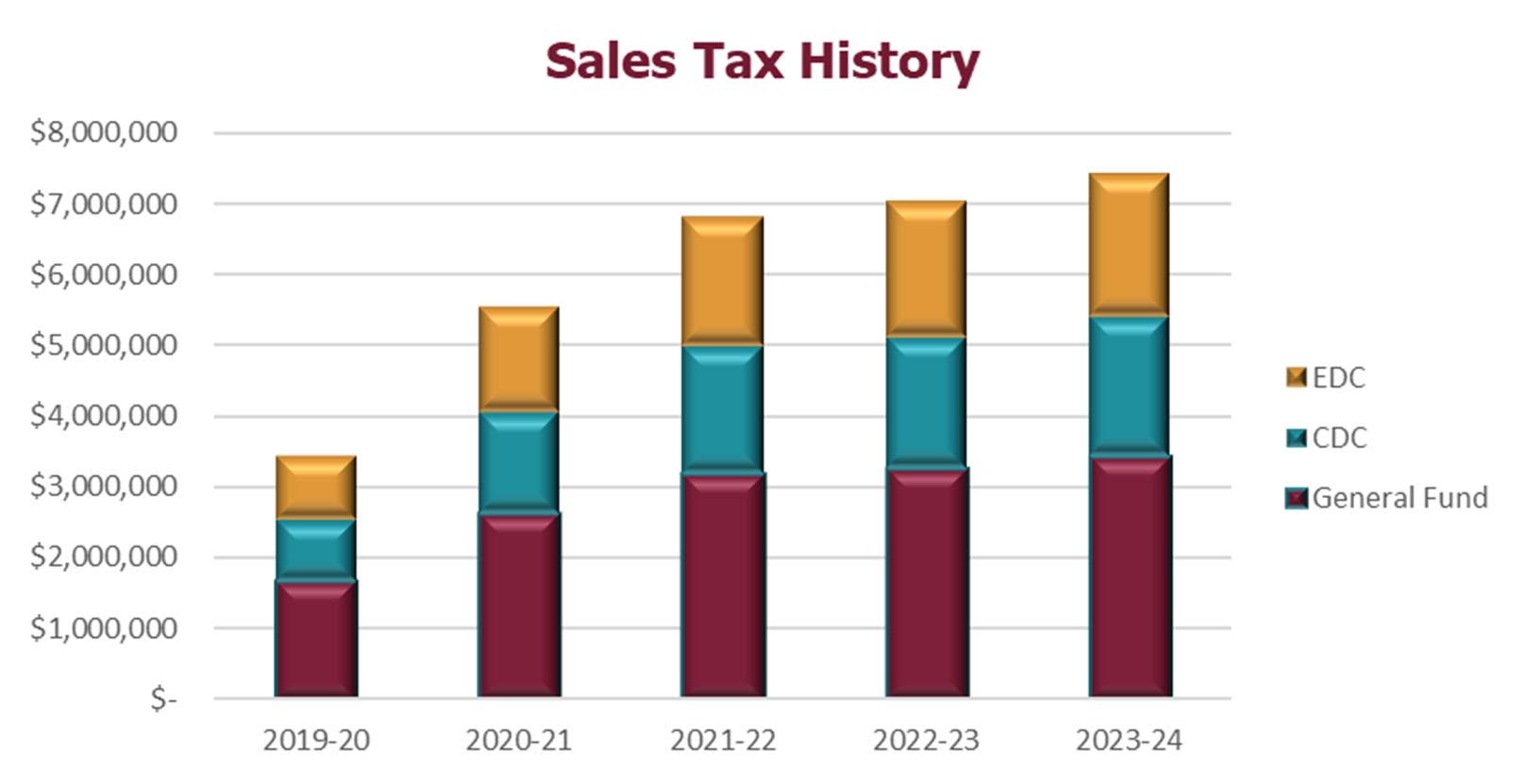
License and permits constitute one of the primary sources of revenue for the City, making it the largest contributor to the General Fund. However, in FY 2021‐22, the City experienced a decline in permits issued due to supply chain disruptions affecting building materials early in the year. Additionally, an increase in interest rates toward the year's end cooled down the housing market. Despite these challenges, Celina's overall revenues have been steadily increasing, aligning with the growth in population and the escalating demands for services. As commercial development continues to expand, recurring sales tax revenues are expected to rise, providing greater flexibility in budget allocations. This shift will gradually reduce the City's reliance one‐time permitting revenues.
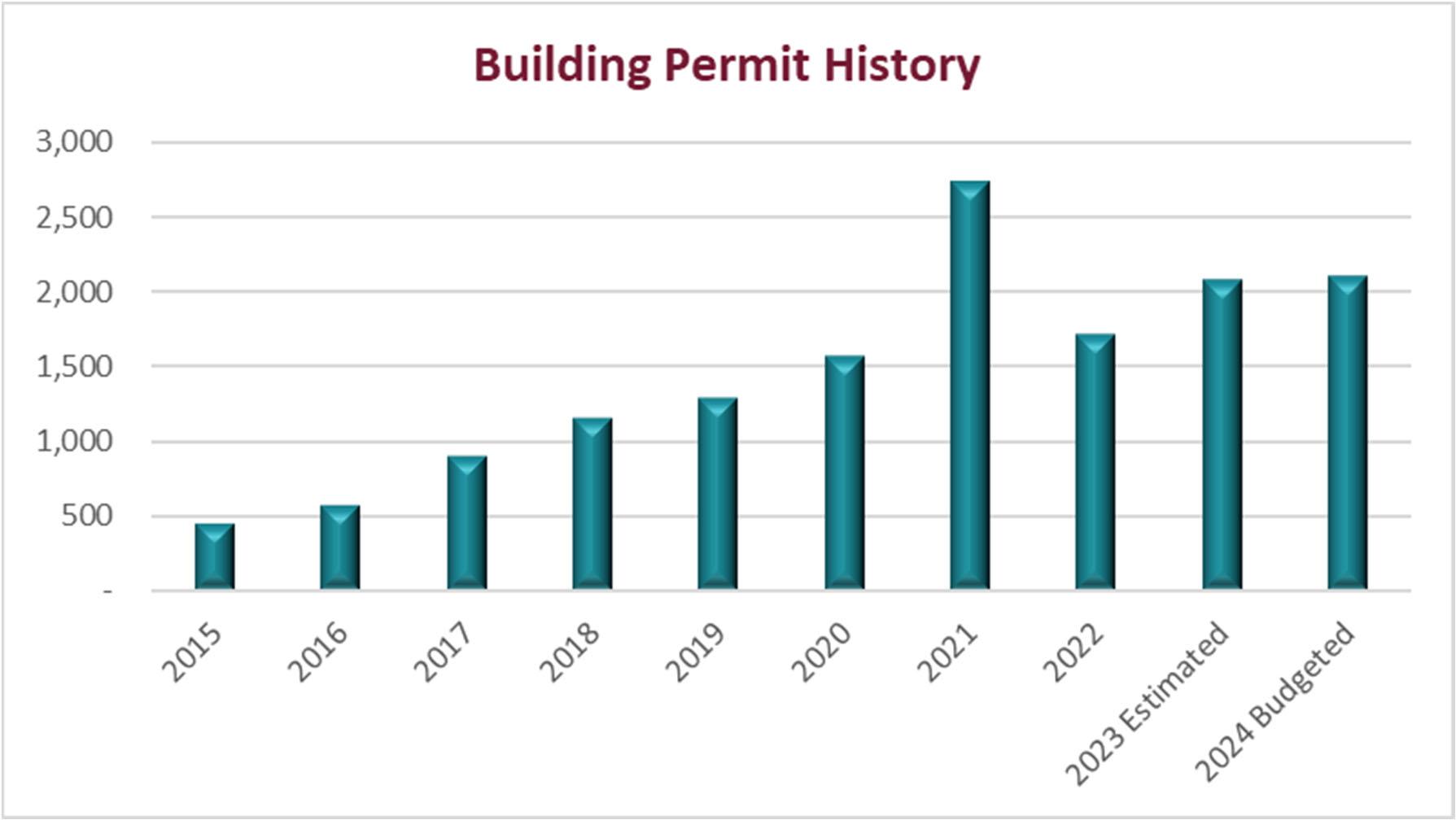
Looking ahead, the revenue outlook for fiscal year 2024 appears promising, indicating positive prospects for the City's financial position and ability to meet its future needs.




The operating budget is a combination of all costs to accomplish comprehensive citywide business including transfers and debt service payments except for the Capital Improvement Project (CIP) Fund. Use of Funds for total combined expenditures are broken down by General Government, Public Safety, Development and Engineering, Recreation and Culture, Public Services, Utilities, Debt Service, and Transfers. The total of the combined operating expenditure budget for FY 2024 is $134,294,333, compared with $101,107,552 budgeted in FY 2023. This is an increase of $33,186,781 or 32.82%.
The General Government budget increased $1,525,186 or 15.33% over 2023. Public Safety increased $5,411,306 or 35.42% over the adopted FY 2022‐23 budget. This increase includes staffing for Fire Station 3 and 12% pay rate increases for Public Safety. Development and Engineering increased $731,944 or 11.30%. Recreation and Culture increased $697,127 or 6.65%. Public Services increased $2,309,278 or 34.67%. Utilities increased $12,527,174 or 33.63%, which is for Water and Wastewater expense increases and for capital projects. Debt Service and Transfers adopted budget totals $24,999,421 in comparison to the adopted 2022‐23 budget of $15,014,655.

The City Fund Summary section of this document provides more detail regarding the individual fund budgets and the total expenditures broken down per fund.

This budget is the final result of the process of listening to the residents of the City of Celina. The 2023‐25 Strategic Plan was a direct result of the 2022 Citizen Survey, and the Budget Document is a direct result of the Strategic Plan.

The below list of service additions and capital projects represent additions to the budget specifically to address goals identified by the Strategic Plan.
1. Be the Life Connected. City: Objectives within this Strategic Plan Goal touch upon quality‐of‐life enhancements that aim to keep residents invested long‐term.
a. 6.0 FTEs including Library Assistants, a Assistant Library Director, Parks Maintenance Workers, a Senior Center Coordinator, a Recreation Manager, and Recreation Attendants.
b. Enhancements to the Cajun and Beware Festivals.
c. A mobile library van and block party trailer.
d. Parks equipment to better maintain the park system which includes a SCAG windstorm blower, z max sprayer, and turf renovation machine.
e. Scheduled design, land acquisition, or construction for CIP projects include, the Wilson Creek Park, Ralph O’Dell Sr. Citizens Center, and Ousley Park Phase 1.
2. Be the Unique City: This Strategic Plan Goal seeks to preserve Celina’s unique heritage through fortifying and expanding Downtown.
a. Downtown street sign replacements.
b. Downtown roadway improvements.
c. Gateway Monuments.
d. Public Art at City Facilities.
3. Be the City of the Future, Connected to its Past: This Strategic Plan Goal seeks to connect current and future residents to Celina’s unique past.
a. Public Wi‐fi on the Downtown Square.
b. Traditions Trail as part of Ousley Park.
4. Be the City Built on Public Safety: Public safety and emergency services are a strength, we intend to fortify them.
a. 9.5 FTEs including Police Officers, School Resource Officers, Mental Health Officer, Neighborhood Services Officer, Detective, and support staff.
b. Police equipment that includes AED’s, radios, a drone, training computers, breaching equipment, pistol optics, 40 mm less lethal equipment, electronic flares, and outfitting for the police headquarters.
c. FF&E for Station 3 and a renovation for station 1.
5. Be the City of Servant Leaders: This goal speaks to our organizational culture to attract and retain the right employees in the right role, who are motivated to serve the community.
a. Peer to Peer Recognition Program.
b. 1.0 FTEs for a Senior Financial Analyst
c. Additions include City‐wide Organizational Development training to include 3rd party speaking engagements.

6. Be the City of Innovative Infrastructure: This Strategic Plan Goal speaks to adopting innovative infrastructure policies and projects that ensure a sustainable path for growth.
a. 9.0 FTEs including Street Maintenance Workers, a Sign Shop Technician, Construction Manager and Inspector, an Assistant Public Works Director, Wastewater Treatment Operators, and a Meter Technician Position.
b. Streets additions include pavement management software, a brine maker for winter weather, pavement striping equipment, and other capital equipment.
c. Utility additions include a mini excavator with trailer, 6/8 yard dump truck, jetter nozzles, a Prinston Piggy Back 55+, and a manhole lifter.
d. Scheduled design, land acquisition, or construction for CIP projects include:
i. Legacy Road (Frontier to Carey Rd)
ii. Coit Road (Vest Lane to Choate Pkwy)
iii. Choate Pkwy (Roseland to Custer)
iv. Coit Road (Frontier Pkwy, to Marigold)
v. Coit Road (Choate to outer Loop)
7. Be the City of Small Business: Objectives in this Strategic Plan Goal include adopting policies, codes, and ordinances that cultivate the right environment for small businesses to thrive.
a. Building Services added 1.0 FTE for a Building Inspector.
b. Façade Grants.
c. Enhanced landscaping on the outer loop.
8. Be the City that Shares Our Story: This Strategic Plan Goal will focus on sharing who we are as a City.
a. Incubator space for Friday Night Market.
b. Ribbon Cuttings for businesses & CIP.
The list below represents significant one‐time expenditures across the total projected FY 2023‐24 combined funds to provide new or upgraded levels of service. The adopted FY 2023‐24 significant one‐time expenses total $2,324,291 and below is a sample listing of some of the expenditures anticipated:
Capital Vehicles $763,381
Capital Equipment $365,976

o Brine Maker
o Pavement Striping Equipment
o Police Side by Side
o PTO‐60 Sports Turf Renovation Machine
o SCAG Windstorm Blower
o Z Max Sprayer
o Jackhammer for Backhoe
o Manhole Lifter
o Mini Excavator
o Trailer for Excavator
Vehicle/Equipment Replacement $1,194,934
o Capital Replacements

Priorities addressed in this budget are to provide adequate funding to maintain service levels amid population growth in the City and to continue to meet the expectations of the community. This budget adopted an increase of 29.5 full‐time equivalent (FTE) positions. This includes 25.5 FTEs in General Fund and 4.0 FTEs in the Water and Wastewater Fund. Of these new positions, 4.0 FTEs are for General Government, 3.0 FTEs Development and Engineering, 6.0 FTEs are for Culture and Recreation, 7.0 FTEs are for Public Services, and 9.5 FTEs are for Public Safety. The new positions including compensation and benefits will total $2,172,483 and are listed below.
General Government ‐ 4.0 FTEs
Service Desk Analyst Public Safety – Information Technology (1.0)
Senior Financial Analyst – Finance (1.0)
Internal Services Management Assistant – Finance (1.0)
Court Clerk – Municipal Court (1.0)
and Engineering ‐ 3.0 FTEs
Building Inspector – Development Services (1.0)
Construction Inspector, ROW – Engineering (1.0)
Construction Manager – Engineering (1.0)
and Recreation ‐ 6.0 FTEs
Part Time Library Assistants – Library (1.0)
Assistant Library Director – Library (1.0)
Part Time Weekend Maintenance – Parks (1.0)
Senior Center Coordinator – Parks (1.0)

Recreation Manager – Parks (1.0)
Part Time Recreation Attendants – Parks (1.0)
Services ‐ 7.0 FTEs
Streets Maintenance Worker – Streets (2.0)
Sign Shop Technician – Streets (1.0)
Assistant Public Works Director – Public Works (1.0)
Wastewater Treatment Operator – Public Works (2.0)
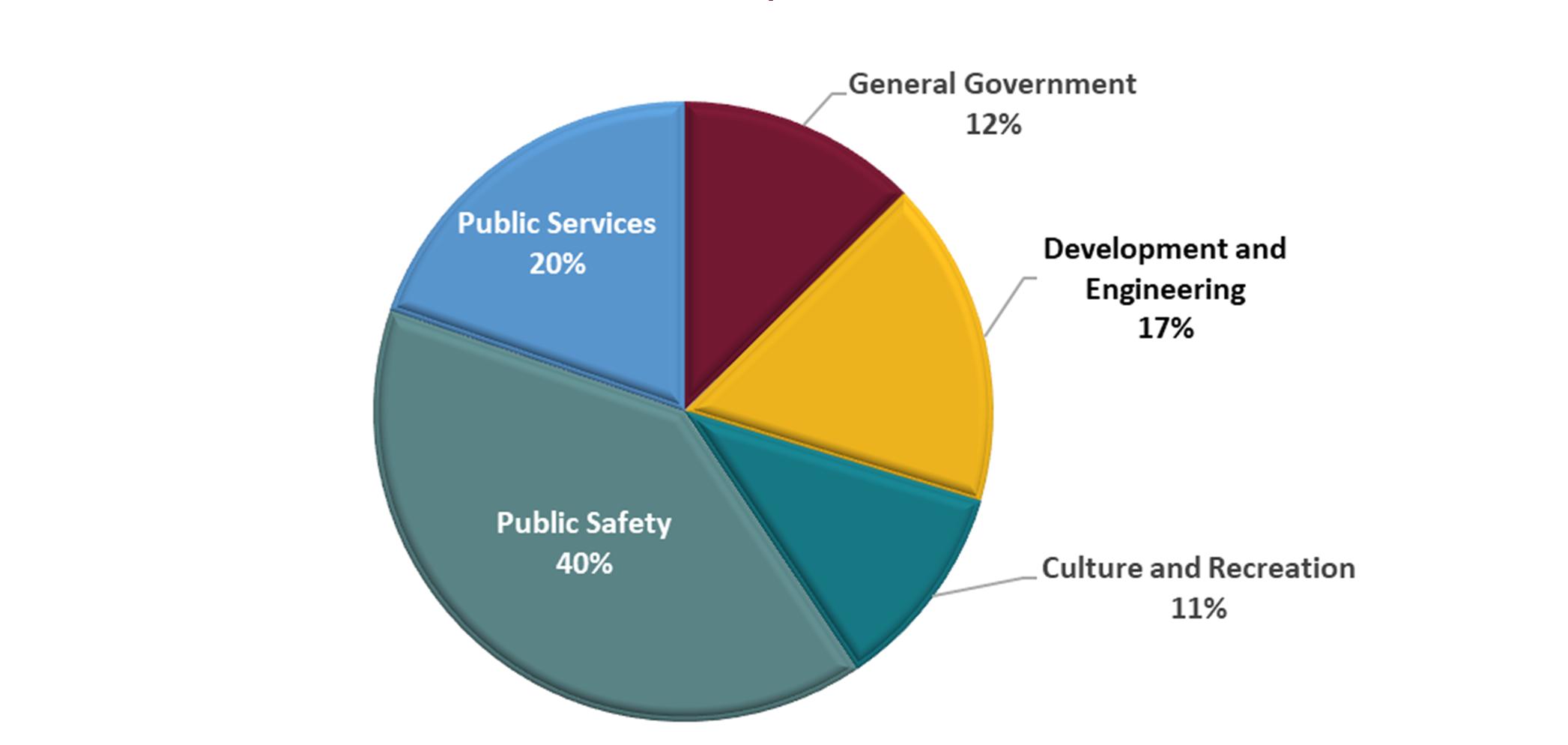
Meter Technician – Customer Service (1.0)
Public Safety 9.5 FTEs
Patrol Officer (Day) – Police (2.0)
Patrol Detective – Police (1.0)
Mental Health Officer – Police (1.0)
Neighborhood Services Officer – Police (1.0)
School Resource Officer – Police (2.0)
Property Evidence Supervisor – Police (1.0)
Record Technician Lead – Police (1.0)
Part Time Administration Coordinator – Police (0.5)
Staffing changes occur throughout the year between departments, the total number of FTEs to close the 2023 budget year is 280.25. The FY 2023‐24 adopted budget maintains the 2023 end of year totals and with the addition of the new positions requested, Celina will begin the 2024 budget year at 309.75 FTEs with a salary and benefits cost of $33,954,750.

The City offers competitive benefits to employees, including group medical, dental, and vision insurance with dependent coverage available. Life and long‐term disability insurances are 100% City paid. Optional insurance offerings are provided for short‐term disability and additional life insurance.

The City participates in Texas Municipal Retirement System (“TMRS”), a statewide administered pension plan. The City’s TMRS plan is a 2 to 1 matching ratio with a 5‐year vesting period. Service eligibility for retirement is age 60 with 5 years of service or any age with 20 years of service. The City provides pension benefits for all its full‐time employees through TMRS. The City continues to contribute 100% of its annual required contribution (ARC) at an actuarially determined rate and is solid. Both the employees and the City make contributions monthly.

Most cities in North Texas utilize Update Service Credits (“USC”) and Cost of Living (“COLA”) adjustment within their TMRS benefit package. To be competitive and retain and attract new employees, it was necessary to update the City’s current plan. This update increased the overall retirement benefit for an employee and was approved in October of 2022, it became available for employees January 1, 2023.
The adopted FY 2024 budget includes a step increase of 3% for general service employees and public works employees. Public Safety step plans for Police and Fire were updated with a 12% increase to the existing pay plan.


There are multiple areas of reserves built into the budget. By ordinance, the City is required to maintain a 25% General Fund Balance. For FY 2024, this amount is approximately $11.25 million.
The Water and Wastewater Fund predicts a working capital reserve of $16.03 million which is approximately 40.89% of FY 2024 expenditures or 149 days of working capital. The Water and Wastewater Fund has multiple revenue sources; however, the main source of revenue is generated by water sales therefore is rate sensitive. Every effort is made to keep rate increases at a minimum with the last rate increase in fiscal year 2020.

General Fund
General Fund Revenue
General Fund revenues and budgeted transfers are budgeted at $43,467,238 for FY 2024. This is an increase of 17.02% or $6,321,876 over the FY 2023 estimate. The main source of revenue into the General Fund are Ad Valorem Taxes and Building Permits, they are forecasted at 67% of the total General Fund revenue for FY 2024. The revenue growth is a result of continued commercial development, new residential construction, and population growth in Celina.
General Fund property taxes for FY 2024 are budgeted at $16,672,043, which is an increase of 47.88% over the FY 2023 budget. The increase is due to reduced contra account payments and new value added to the tax rolls. Certified property values for FY 2024 are $5,897,434,904 which is $1,760,044,401 or 42.5% more than FY 2023 adjusted values. Much of this increase is due to $846,641,891 of new value that was added to the tax rolls as of January 1, 2023. The O&M tax rate is $0.315878/$100 of value. This is $0.056824 below the O&M rate for FY 2023 of $0.372702. Property tax values continue to increase in Celina as more new construction takes place.
Celina’s commercial development has not yet caught up to the residential expansion in recent years and as a result sales tax is only 8% of budgeted revenue in FY 2024. The FY 2024 sales tax budget is $4,042,500 which is a 5% increase over FY 2023. Commercial development is picking up in Celina with land acquisitions by Costco and HEB and new businesses opening along Preston Road and Downtown. City staff will continue to monitor this revenue source closely.

General Fund building permit revenue for FY 2024 is budgeted at $12,500,000 which is an increase of 25% over the FY 2023 budget. This is due to increased development resulting in higher fee revenue. There are estimated to be 2,075 building permits in FY 2023 and 2,100 in FY 2024. Building permit revenue is one time revenue. As the City builds out this revenue source will decrease and be replaced by an increase in sales and property tax revenue.





The General Fund encompasses the basic services of municipal government. These services include Police, Fire, Streets, Development Services, Parks, Public Works, Administration, and all other internal services.

General Fund operating expenditures total $43,322,178 before transfers out. With transfers, the total General Fund budget for FY 2023 is $44,310,436. This budget is a 27.36% increase or $9,518,236 more than the FY 2023 budget.
The General Fund transfer to the Vehicle and Equipment Replacement (VERF) Fund for FY 2024 is budgeted at $988,258. The VERF Fund is a separate fund that provides for the replacement of capital vehicles and equipment. FY 2024 will see an increase of $142,344 from the adopted 2023 budget of $845,914. This increase in transfers is a result of the increased number of capital vehicles and equipment.
The General Fund expenditure budget is broken down by department and grouped into categories by major function. The categories are General Government, Public Safety, Development and Engineering, Recreation and Culture, and Public Services. Overall, Public Safety makes up the largest cost center of general‐purpose operations with a combined budget of $18.99 million or 43.84% of the total General Fund operating expenditures Budget in FY 2024. Public Safety is comprised of Fire & EMS and Police.

General Government includes Administration, City Secretary, Finance, Human Resources, Information Technology, Municipal Court, and Facility Maintenance. These departments have a total of 38 FTEs which includes 4 new FTEs for the FY 2024 Budget. The General Government budget for FY 2024 is $9.01 million which is $1.51 million or 20.12% above the FY 2023 budget.
Public Safety is comprised of the Police and Fire Departments. Fire & EMS will have a total of 60 personnel with a adopted operating budget of $9.24 million, an increase over the adopted FY 2023 budget by $2.34 million. This department makes up 21.33% of the adopted general operating fund budget for the upcoming year. Fire Station No. 3 will be completed and become staffed in FY 2024. The Police Department’s adopted budget for FY 2024 is $9.75 million and amounts to 22.51% of the general operating budget. The FY 2024 budget contains 9.5 new FTEs, with the addition of two Officers, a Neighborhood Services Officer, two School Resource Officers, a Detective, a Mental Health Officer, a Property Evidence Supervisor, a Record Technician Lead, and additional part time hours for office administration.

Development and Engineering includes the Development Services, GIS, and Engineering. It has an adopted budget totaling $7.14 million. An increase over FY 2023 of $726,741 or 11.34% and will have a personnel count of 53 FTEs. There are 3 new positions added in FY 2024 for a Building Inspector, Construction Inspector, and Construction Manager. Development Services is on pace to process around 2,075 residential building permits for the City for the 2022‐23 fiscal year and Development and Engineering represents 16.47% of the overall general operating fund budget.
Recreation and Culture includes Library, Parks and Recreation, and Marketing/Special Events. These departments have a total of 33.75 FTEs which includes 6 new FTEs for the recreation center programming, library staff, senior center, and parks maintenance in FY 2024 Budget. The Recreation and Culture budget for FY 2024 is $5.48 million which is $1.56 million or 39.71% above the FY 2023 budget.

Public Services includes the Streets Department in General Fund. Streets has a total of 12 FTEs which includes 3 new FTEs for street maintenance and sign maintenance in FY 2024 Budget. The Street budget for FY 2024 is $2.70 million which is $777,753 or 40.46% above the FY 2023 budget.


Water and Wastewater, Solid Waste, Utility Infrastructure, Impact Fees, Capital Recovery, Stormwater Drainage, and Utility Vehicle and Equipment Replacement Fund (VERF) account for the full‐service operations of the water and wastewater system including water production, water distribution, wastewater collection, wastewater reclamation, solid waste collection and disposal, and capital improvements. The Enterprise funds are 100% self‐supporting with revenues generated from rates, charges, and fees sufficient to cover operations, debt, scheduled capital outlay purchases, and capital infrastructure projects. They act as business enterprises, utilize full accrual accounting, and separate water and wastewater operations to make each operation self‐supporting.

The Water & Wastewater Fund (“the utility system”) accounts for water and wastewater operations of the City of Celina. The operations of the utility system include administration, water distribution, wastewater collection, wastewater reclamation, system maintenance, and Utility Customer Service. Water and Wastewater services are provided to both residential and

commercial customers. Currently, the City of Celina has 13,142 utility accounts that are serviced. Separately, the City is contracted by Denton County Fresh Water Supply District 10 which recently updated their name to Elm Ridge Water Control and Improvement District to perform and manage their water utility maintenance and billing.

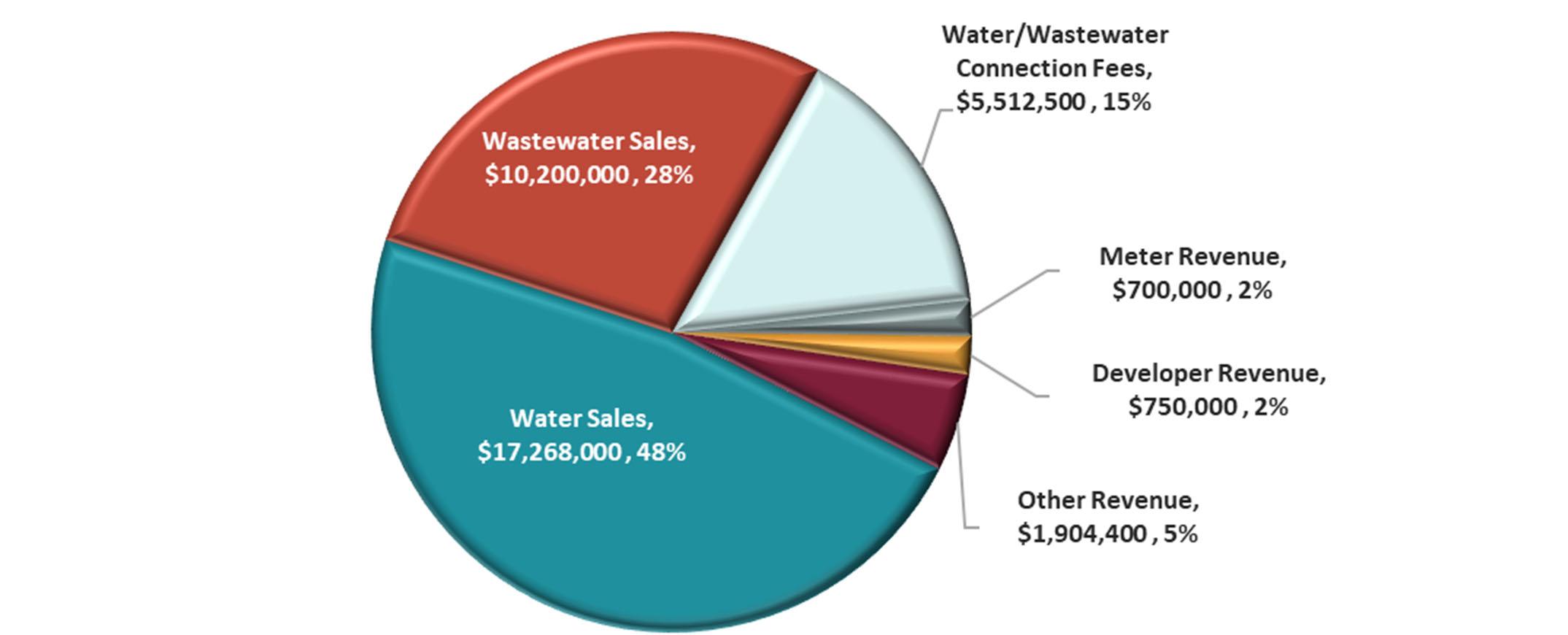
The total Water & Wastewater Fund revenue is forecasted at $36,334,900 for FY 2024. This includes water & wastewater sales, connections fees, meter and developer fees, and other fees and charges. Other fees and charges are related to services performed in the field for new connections as well as penalties on late payments and disconnects, and interest.
Sources of revenue supporting the City’s utility system.
Other revenue sources include impact fees, capital fees and developer contributions. The City does assess and collect these fees to help support the costs of infrastructure associated with new development for both commercial and residential development.
Infrastructure projects include water, wastewater, and stormwater drainage. Some of the current and future projects that are funded from these revenues include waterline construction, wastewater treatment plant construction, and drainage improvements within the City. Revenues for these funds are adopted at $14,990,000 for the 2023‐24 fiscal year.

Water has a total of twenty‐three (23) FTEs. This includes one FTE moving to the Vehicle Replacement Fund, and adding one FTE in the FY 2024 budget. The adopted operating budget is $13,262,118. It is an increase over the adopted FY 2023 budget of $11,252,353 and makes up 33.72% of the Water & Wastewater Fund operating fund budget for the upcoming year. The budget includes a pass‐through increase for water purchased through the Upper Trinity Regional Water District (UTRWD). The rate for purchased water increased 2.8% per 1,000 gallons.
Wastewater will have a total of 15 FTEs which includes two new FTEs with an adopted operating budget of $4,321,187 an increase over the FY 2022‐23 budget of $3,381,862 and is 10.13% of the fund budget.
Utility Billing has a total of 7 FTEs which includes 1 new FTE with a budget of $1,014,614. All other operating expenditures including both City and Upper Trinity Regional Water District debt is $14,774,581.
Impact and Capital Recovery operation costs are anticipated at $12,000,000 with an additional transfer to other Enterprise funds of $750,000 for FY 2023‐24. These costs cover the engineering, construction, testing, and land acquisitions for capital water & wastewater projects that are mentioned in the above passages.

This fund plays a crucial role in enhancing the City's aesthetics and overall appeal. The revenues collected are dedicated to various beautification projects, such as sidewalk improvements, street landscaping, signage installations, lighting enhancements, and façade improvements. Additionally, the fund supports engaging community events like "Music on the Square" and the promotion of public art initiatives.
The primary sources of funding are generated from water tower rental fees, cell tower lease fees, tree mitigation fees, and warning device fees. With these resources, the City has been able to embark on significant improvements, making Celina a more attractive and inviting place for residents and visitors alike.
In FY 2022, Celina introduced the "Neighborhood Integrity Program," providing grants to Homeowners Associations to enhance neighborhood amenities and features. Furthermore, in the same budget year, the City began setting aside funds from this account specifically for the construction of storm warning devices, reinforcing community safety measures.

For FY 2023‐24, the projected revenue for this fund is set at $415,000, with operational expenses totaling $365,000. Anticipated expenses in the coming fiscal year include supporting façade grants, the Neighborhood Integrity Program, "Music on the Square" events, public art initiatives, Arbor Day tree planting, and property abatement activities. These investments will further elevate the City's charm and create an appealing and well‐maintained environment for residents, visitors, and businesses to enjoy.
The Capital Acquisition Fund is a fund that Celina uses to allocate a portion of surplus revenues for future capital expenditures. Fiscal Year 2023‐24 scheduled expenditures include:
Police Equipment $144,700
Law Enforcement Center FF&E $350,573
Fire Station No. 3 FF&E $382,000
Fire Station No. 3 Emergency Signal $200,000
Fire Station No. 1 Water Line $22,000
School Zone Flashers $200,000
Gateway Monuments $150,000
Streets Equipment $34,200
Mobile Library Van $77,000
Hydro Vac Trailer $93,500
In FY 2023, the City of Celina funded capital project needs through a series of Certificates of Obligation for General and Water & Wastewater totaling $98.0 million. This follows up issuances in FY 2022 of $70.0 million and FY 2021 of $95.5 million. Projects are completed through a phased approach and are based on identified needs as the City continues to grow.
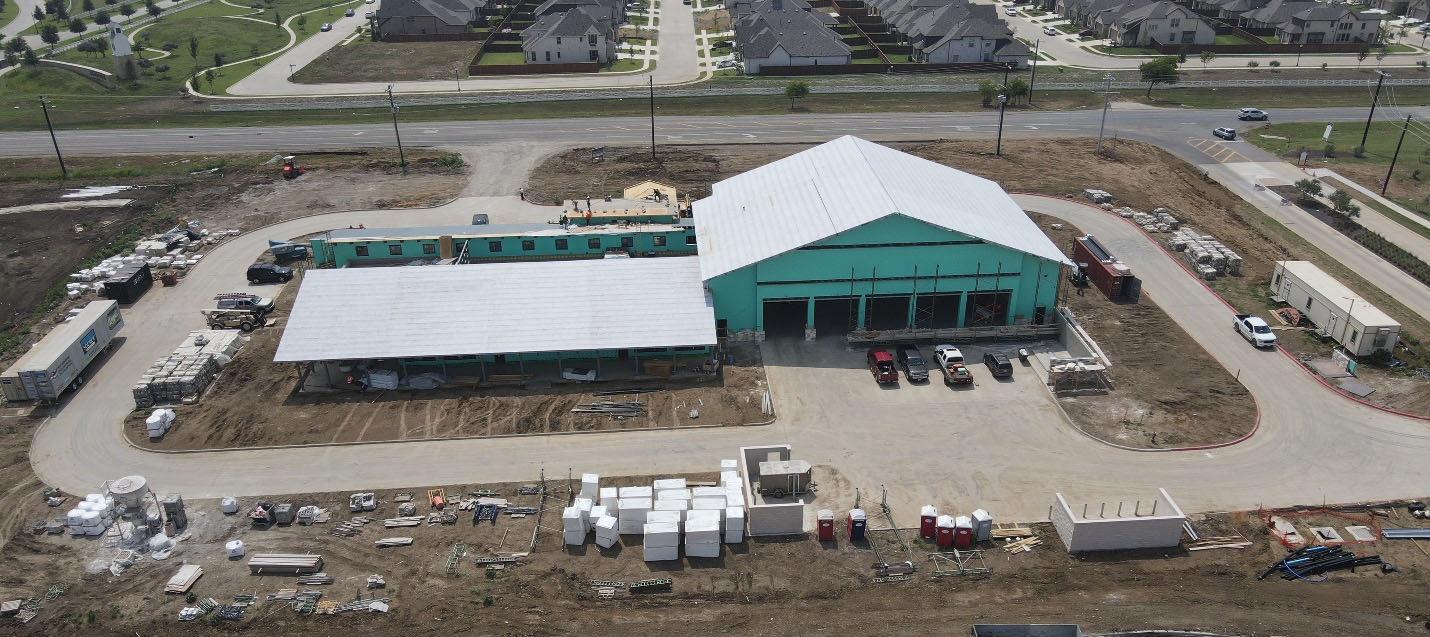

The following is a list of some of the major projects that the City has scheduled for design or construction the coming fiscal year:
Law Enforcement Center construction
Fire Station No. 3 construction
Preston Road Phase 3 Street Lighting
Senior Center construction
Legacy Hills Water Reclamation Plant
Coit Waterline construction
Emergency Data Recovery Center
Ousley Park
Glendenning Park Development
Downtown Water & Sewer Upgrades
Legacy Hills Water & Wastewater upsize construction
Wilson Creek Park Phase 1 Design
Dallas Parkway Waterline from Celina Road pump station to J Fred Smith
Choate Parkway from Kinship to Custer – design
Coit Road from Vest Lane to Outer Loop – design
Ousley Park Design Development
Fire Station No. 3 Construction
A tax increment reinvestment zone (TIRZ) is created by ordinance with the City Council of the City of Celina. It designates a contiguous geographic area within the City as a reinvestment zone pursuant to Chapter 311 of the Texas Tax Code. The TIRZ is funded by an incremental allocation of percentage or rate basis for each and is an obligation of the City’s property tax. This economic development tool is a fundamental component in creating the strong residential development in Celina. The majority of the TIRZs overlay Public Improvement Districts. TIRZ 11 is specific to the Downtown Corridor. TIRZ 11 is supported by the City, EDC, CDC and Collin County. This zone has collections from Property Tax and Sales Tax.

The City of Celina participates in eleven TIRZ, TIRZ #11 for Downtown (described below). These eleven TIRZ are dedicated to include:
#2 Creeks of Legacy
#4 Sutton Fields
#5 Old Celina Limited
#6 Glen Crossing
#7 Ownsby Farms
#8 Sutton Fields II
#9 The Columns
#10 Chalk Hill
#11 Downtown
#12 Edgewood Creek
#13 Legacy Hills






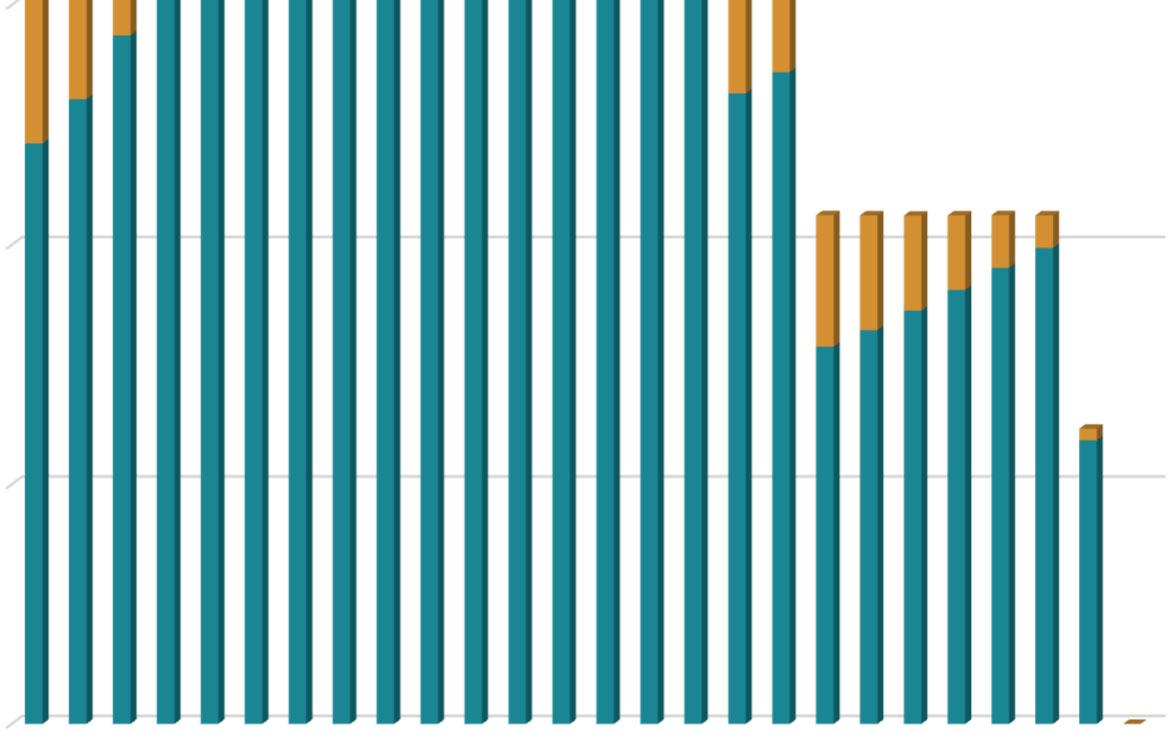

























The Departments that comprise the General Fund on a budgetary presentation are GIS, Facilities Maintenance, Information Technology, Finance, Library, City Secretary, Development Services, Administration, Municipal Court, Fire & EMS, Streets, Police, Parks and Recreation, Marketing and Special Events, Engineering, and Human Resources.

and City Council
Attorney City Manager
Office
*Utility Billing is in the Finance Department but funded out of the Water & Wastewater Fund.







The Debt Service Fund accumulates and makes payments of principal and interest on long‐term debt secured by the general taxing powers of the City of Celina. The Water and Wastewater Fund makes payments of principal and interest on long‐term debt secured by utility revenues.

The City will not issue debt for current operations but rather for capital improvements and related expenses. Debt may be issued for purchasing land or rights‐of‐way, constructing capital improvements, or purchasing capital equipment. Bonds will be paid back within a period that does not exceed the useful life of the asset.
Note – Celina’s bond rating increased from Aa3 to Aa2 in FY 2023.





The Water & Wastewater Fund is part of the Public Works Department and provides potable water and treats wastewater from its customers. The major functions of the fund are administration, water distribution, wastewater collection, wastewater treatment, utility billing, and water metering.
The Solid Waste Fund was established in fiscal year 2022 to more accurately track the revenues and expenses of the solid waste collection service. Prior to fiscal year 2022 Solid Waste activities were included in the Water & Wastewater Fund.
The Infrastructure Fund is used for capital infrastructure purchases from other funding sources.
The Utility Impact Fee Fund provides a mechanism of funding to Water and Wastewater projects impacted by new development. Impact fees paid by developers for new construction or upsizing existing structures. The revenue is used to pay for the increased demand put on the system by the new development. These fees fund ca pital projects identified in impact fee studies for upsizing distribution systems, collection systems, and increasing plant capacity.
The Stormwater Drainage Fund collects revenue from Stormwater Fees determined by the square footage of impermeable surfaces on a property. This money is designated for Stormwater operating and capital improvement activities.
The Water Capital Recovery Fund is used for capital infrastructure and capital equipment purchases.
The Sewer Capital Recovery Fund is used for capital infrastructure and capital equipment purchases.

The Vehicle and Equipment Replacement Fund provides a funding source to replace vehicles and equipment for each of the utility funds. Each utility pays a portion of the replacement cost of their vehicles and equipment over the life of the assets until the full replacement cost is recovered.















The Water & Wastewater Fund is part of the Public Works Department and provides potable water and treats wastewater from its customers. The major functions of the fund are administration, water distribution, wastewater collection, wastewater treatment, utility billing and water metering.

Infrastructure, Impact, & Capital Fee Fund - 205, 206, 209, 210
•Park Fee 109
•Downtown 112
•PEG 114
•Grants 115
•Seizures and Forfeitures 116

•Court Security 118
•Court Technology 119

•Technology 122


•Integrity 123
•TIRZ #11 Downtown 311
•Developer Capital Fee 450
•Wilson Park Fee 451
The Park Fee Fund receives revenue from developer agreements and is used for parks specific capital projects.
The Downtown Fund receives revenues from special events and uses those revenues to provide future funding to downtown special events and activities.
The PEG Fund is used to track revenues and expenditures for Public, Educational, and Government Access Channels (PEG) related activities. Revenues are derived from fees charged to cable subscribers.
The Grants Fund is used to track the various grant awards the City of Celina receives. There are specific requirements for each grant therefore a fund was set up to track the revenues and expenses separately.

The Seizures and Forfeitures Fund is used to track revenue from seizures and used on Police Department specific expenses.
The Court Security Fund is set by Code of Criminal Procedure 102.017 and is used for security personnel, services, and items related to buildings that house the court. The revenue is set chapters 134 and 135 of the Local Government Code which includes court fees for filing civil cases and for criminal convictions.
The Court Technology Fund is set by Code of Criminal Procedure 102.0172 and is used for purchase of or to maintain technological enhancements for a municipal court or municipal court record. The funding is from Local Government Code section 134.103, non‐jailable misdemeanor convictions.
The Technology Fund pays for technology infrastructure improvements and computer hardware and software needs. The funding comes from developer fees assigned when obtaining building permits.
This fund helps with the beautification of the City of Celina. The revenues collected are allocated for improvements for sidewalks, street landscaping, signage, lighting, and façade improvements as well as Music on the Square and public art. The funding for this fund comes predominantly from Water Tower Rental fees, Tree Mitigation fees, and Warning Device fees.

The TIRZ #11 Downtown Fund receives property tax revenue from within the downtown TIRZ boundary. That revenue is reinvested within downtown Celina with capital improvement projects.
The Developer Capital Fee Fund accounts for the fees paid to build capital projects per individual agreements with developers.
The Wilson Park Fee Fund is used to track development revenue and expenses dedicated to Wilson Creek Park capital improvement projects.




The Street Construction Fund is used to support streets projects with general government revenue funding. Surplus revenues from General Fund are transferred to the street construction fund at year end.
Roadway impact fees are fees assessed to new development in the city and are used specifically for roadway improvements within the city. These funds can be used along with a bond issuance to pay for streets and help to keep the amount of debt that needs to be issued lower.
The Vehicle and Equipment Replacement Fund is used to provide a funding source to replace vehicles and equipment for each of the General Fund departments. A portion of the replacement cost for each vehicle and piece of equipment is transferred to this fund over the life of the asset until the full replacement cost is recovered. The Fleet Department is included in this fund as of FY 2024.
The Capital Acquisition Fund is a fund that the City uses to allocate a portion of surplus revenues for future capital expenditures.

The Roadway Capital Recovery Fund is used for roadway infrastructure and is paid by developers through development fees to the City. These funds can be used along with a bond issuance to pay for streets and help to keep the amount of debt that needs to be issued lower.




Fund 621 General
Fund 621 is for the tracking of Certificates of Obligation Series 2021 issued for General Government public improvements.
Fund 601 A Public Safety

Fund 601 A is for the tracking of Certificates of Obligation Series 2021A issued for General Government public safety improvements.
Fund 721 Water & Wastewater
Fund 721 is for the tracking of Certificates of Obligation Series 2021 issued for Water and Wastewater public improvements.
Fund 622 General
Fund 622 is for the tracking of Certificates of Obligation Series 2022 issued for General Government public improvements.
Fund 722 Water & Wastewater
Fund 722 is for the tracking of Certificates of Obligation Series 2022 issued for Water and Wastewater public improvements.
Fund 623 General
Fund 623 is for the tracking of Certificates of Obligation Series 2023 issued for General Government public improvements.
Fund 723 Water & Wastewater
Fund 723 is for the tracking of Certificates of Obligation Series 2023 issued for Water and Wastewater public improvements.







The Celina Economic Development Corporation (EDC) is a Non‐Profit Corporation funded by 0.5% sales tax for economic development. The EDC is governed by a 5‐member Board of Directors and uses revenues to fund programs related to industrial development, business infrastructure, and the promotion of new and expanded business enterprises that create or retain primary jobs.

The Celina Community Development Corporation (CDC) is a Non‐Profit Corporation funded by 0.5% sales tax for community development. The CDC is governed by a Board of Directors and uses revenues to fund programs related economic development and quality of life projects.
142 North Ohio Street, Celina, TX 75009
GENERAL INFORMATION: Tax Code Section 26.04(c) requires an officer or employee designated by the governing body to calculate the no-new-revenue (NNR) tax rate and voter-approval tax rate for the taxing unit. These tax rates are expressed in dollars per $100 of taxable value calculated. The calculation process starts after the chief appraiser delivers to the taxing unit the certified appraisal roll and the estimated values of properties under protest. The designated officer or employee shall certify that the officer or employee has accurately calculated the tax rates and used values shown for the certified appraisal roll or certified estimate. The officer or employee submits the rates to the governing body by Aug. 7 or as soon thereafter as practicable.
School districts do not use this form, but instead use Comptroller Form 50-859 Tax Rate Calculation Worksheet, School District without Chapter 313 Agreements or Comptroller Form 50-884 Tax Rate Calculation Worksheet, School District with Chapter 313 Agreements.
Water districts as defined under Water Code Section 49.001(1) do not use this form, but instead use Comptroller Form 50-858 Water District Voter-Approval Tax Rate Worksheet for Low Tax Rate and Developing Districts or Comptroller Form 50-860 Developed Water District Voter-Approval Tax Rate Worksheet.
The Comptroller’s office provides this worksheet to assist taxing units in determining tax rates. The information provided in this worksheet is offered as technical assistance and not legal advice. Taxing units should consult legal counsel for interpretations of law regarding tax rate preparation and adoption.
The NNR tax rate enables the public to evaluate the relationship between taxes for the prior year and for the current year based on a tax rate that would produce the same amount of taxes (no new taxes) if applied to the same properties that are taxed in both years. When appraisal values increase, the NNR tax rate should decrease.
The NNR tax rate for a county is the sum of the NNR tax rates calculated for each type of tax the county levies.
While uncommon, it is possible for a taxing unit to provide an exemption for only maintenance and operations taxes. In this case, the taxing unit will need to calculate the NNR tax rate separately for the maintenance and operations tax and the debt tax, then add the two components together.
1. 2022 total taxable value. Enter the amount of 2022 taxable value on the 2022 tax roll today. Include any adjustments since last year’s certification; exclude Tax Code Section 25.25(d) one-fourth and one-third over-appraisal corrections from these adjustments. Exclude any property value subject to an appeal under Chapter 42 as of July 25 (will add undisputed value in Line 6). This total includes the taxable value of homesteads with tax ceilings (will deduct in Line 2) and the captured value for tax increment financing (adjustment is made by deducting TIF taxes, as reflected in Line 17).1 $
2. 2022 tax ceilings. Counties, cities and junior college districts. Enter 2022 total taxable value of homesteads with tax ceilings. These include the homesteads of homeowners age 65 or older or disabled. Other taxing units enter 0. If your taxing unit adopted the tax ceiling provision in 2022 or a prior year for homeowners age 65 or older or disabled, use this step.2 $
3. Preliminary 2022 adjusted taxable value. Subtract Line 2 from Line 1.
4. 2022 total adopted tax rate.
5. 2022 taxable value lost because court appeals of ARB decisions reduced 2022 appraised value.
A. Original 2022 ARB values: $
B. 2022 values resulting from final court decisions:
C. 2022 value loss. Subtract B from A.3
6. 2022 taxable value subject to an appeal under Chapter 42, as of July 25.
A. 2022 ARB certified value:
B. 2022 disputed value:
C. 2022 undisputed value. Subtract B from A. 4
7. 2022 Chapter 42 related adjusted values. Add Line 5C and Line 6C.
8. 2022 taxable value, adjusted for actual and potential court-ordered adjustments. Add Line 3 and Line 7.
9. 2022 taxable value of property in territory the taxing unit deannexed after Jan. 1, 2022. Enter the 2022 value of property in deannexed territory 5
10. 2022 taxable value lost because property first qualified for an exemption in 2023. If the taxing unit increased an original exemption, use the difference between the original exempted amount and the increased exempted amount. Do not include value lost due to freeport, goodsin-transit, temporary disaster exemptions. Note that lowering the amount or percentage of an existing exemption in 2023 does not create a new exemption or reduce taxable value.
A. Absolute exemptions. Use 2022 market value: $
B. Partial exemptions. 2023 exemption amount or 2023 percentage exemption times 2022 value:
C. Value loss. Add A and B. 6
11. 2022 taxable value lost because property first qualified for agricultural appraisal (1-d or 1-d-1), timber appraisal, recreational/scenic appraisal or public access airport special appraisal in 2023. Use only properties that qualified in 2023 for the first time; do not use properties that qualified in 2022.
A. 2022 market value: $
B. 2023 productivity or special appraised value: - $
C. Value loss. Subtract B from A. 7 $
12. Total adjustments for lost value. Add Lines 9, 10C and 11C. $
13. 2022 captured value of property in a TIF. Enter the total value of 2022 captured appraised value of property taxable by a taxing unit in a tax increment financing zone for which 2022 taxes were deposited into the tax increment fund. 8 If the taxing unit has no captured appraised value in line 18D, enter 0. $
14. 2022 total value. Subtract Line 12 and Line 13 from Line 8. $
15. Adjusted 2022 total levy. Multiply Line 4 by Line 14 and divide by $100. $
16. Taxes refunded for years preceding tax year 2022. Enter the amount of taxes refunded by the taxing unit for tax years preceding tax year 2022. Types of refunds include court decisions, Tax Code Section 25.25(b) and (c) corrections and Tax Code Section 31.11 payment errors. Do not include refunds for tax year 2022. This line applies only to tax years preceding tax year 2022. 9
17. Adjusted 2022 levy with refunds and TIF adjustment. Add Lines 15 and 16. 10 $
18. Total 2023 taxable value on the 2023 certified appraisal roll today. This value includes only certified values or certified estimate of values and includes the total taxable value of homesteads with tax ceilings (will deduct in Line 20). These homesteads include homeowners age 65 or older or disabled. 11
A. Certified values: $
B. Counties: Include railroad rolling stock values certified by the Comptroller’s office: + $
C. Pollution control and energy storage system exemption: Deduct the value of property exempted for the current tax year for the first time as pollution control or energy storage system property: - $
D. Tax increment financing: Deduct the 2023 captured appraised value of property taxable by a taxing unit in a tax increment financing zone for which the 2023 taxes will be deposited into the tax increment fund. Do not include any new property value that will be included in Line 23 below. 12 - $
E. Total 2023 value. Add A and B, then subtract C and D.
19. Total value of properties under protest or not included on certified appraisal roll. 13
A. 2023 taxable value of properties under protest. The chief appraiser certifies a list of properties still under ARB protest. The list shows the appraisal district’s value and the taxpayer’s claimed value, if any, or an estimate of the value if the taxpayer wins. For each of the properties under protest, use the lowest of these values. Enter the total value under protest. 14 $
B. 2023 value of properties not under protest or included on certified appraisal roll. The chief appraiser gives taxing units a list of those taxable properties that the chief appraiser knows about but are not included in the appraisal roll certification. These properties also are not on the list of properties that are still under protest. On this list of properties, the chief appraiser includes the market value, appraised value and exemptions for the preceding year and a reasonable estimate of the market value, appraised value and exemptions for the current year. Use the lower market, appraised or taxable value (as appropriate). Enter the total value of property not on the certified roll. 15
C. Total value under protest or not certified. Add A and B.
20. 2023 tax ceilings. Counties, cities and junior colleges enter 2023 total taxable value of homesteads with tax ceilings. These include the homesteads of homeowners age 65 or older or disabled. Other taxing units enter 0. If your taxing unit adopted the tax ceiling provision in 2022 or a prior year for homeowners age 65 or older or disabled, use this step.16
21. 2023 total taxable value. Add Lines 18E and 19C. Subtract Line 20. 17
22. Total 2023 taxable value of properties in territory annexed after Jan. 1, 2022. Include both real and personal property. Enter the 2023 value of property in territory annexed. 18 $
23. Total 2023 taxable value of new improvements and new personal property located in new improvements. New means the item was not on the appraisal roll in 2022. An improvement is a building, structure, fixture or fence erected on or affixed to land. New additions to existing improvements may be included if the appraised value can be determined. New personal property in a new improvement must have been brought into the taxing unit after Jan. 1, 2022 and be located in a new improvement. New improvements do include property on which a tax abatement agreement has expired for 2023. 19
24. Total adjustments to the 2023 taxable value. Add Lines 22 and 23. $
25. Adjusted 2023 taxable value. Subtract Line 24 from Line 21. $
26. 2023 NNR tax rate. Divide Line 17 by Line 25 and multiply by $100. 20 $
27. COUNTIES ONLY. Add together the NNR tax rates for each type of tax the county levies. The total is the 2023 county NNR tax rate. 21 $ /$100
The voter-approval tax rate is the highest tax rate that a taxing unit may adopt without holding an election to seek voter approval of the rate. The voter-approval tax rate is split into two separate rates:
1. Maintenance and Operations (M&O) Tax Rate: The M&O portion is the tax rate that is needed to raise the same amount of taxes that the taxing unit levied in the prior year plus the applicable percentage allowed by law. This rate accounts for such things as salaries, utilities and day-to-day operations.
2. Debt Rate: The debt rate includes the debt service necessary to pay the taxing unit’s debt payments in the coming year. This rate accounts for principal and interest on bonds and other debt secured by property tax revenue.
The voter-approval tax rate for a county is the sum of the voter-approval tax rates calculated for each type of tax the county levies. In most cases the voter-approval tax rate exceeds the no-new-revenue tax rate, but occasionally decreases in a taxing unit’s debt service will cause the NNR tax rate to be higher than the voter-approval tax rate.
28. 2022 M&O tax rate. Enter the 2022 M&O tax rate.
29. 2022 taxable value, adjusted for actual and potential court-ordered adjustments. Enter the amount in Line 8 of the No-New-Revenue Tax Rate Worksheet.
30. Total 2022 M&O levy. Multiply Line 28 by Line 29 and divide by $100
31. Adjusted 2022 levy for calculating NNR M&O rate.
A. M&O taxes refunded for years preceding tax year 2022. Enter the amount of M&O taxes refunded in the preceding year for taxes before that year. Types of refunds include court decisions, Tax Code Section 25.25(b) and (c) corrections and Tax Code Section 31.11 payment errors. Do not include refunds for tax year 2022. This line applies only to tax years preceding tax year 2022. .............. + $
B. 2022 taxes in TIF. Enter the amount of taxes paid into the tax increment fund for a reinvestment zone as agreed by the taxing unit. If the taxing unit has no 2023 captured appraised value in Line 18D, enter 0. – $
C. 2022 transferred function. If discontinuing all of a department, function or activity and transferring it to another taxing unit by written contract, enter the amount spent by the taxing unit discontinuing the function in the 12 months preceding the month of this calculation. If the taxing unit did not operate this function for this 12-month period, use the amount spent in the last full fiscal year in which the taxing unit operated the function. The taxing unit discontinuing the function will subtract this amount in D below. The taxing unit receiving the function will add this amount in D below. Other taxing units enter 0. +/- $
D. 2022 M&O levy adjustments. Subtract B from A. For taxing unit with C, subtract if discontinuing function and add if receiving function. $
E. Add Line 30 to 31D.
32. Adjusted 2023 taxable value. Enter the amount in Line 25 of the No-New-Revenue Tax Rate Worksheet. $
33. 2023 NNR M&O rate (unadjusted). Divide Line 31E by Line 32 and multiply by $100.
34. Rate adjustment for state criminal justice mandate. 23
If not applicable or less than zero, enter 0.
A. 2023 state criminal justice mandate. Enter the amount spent by a county in the previous 12 months providing for the maintenance and operation cost of keeping inmates in county-paid facilities after they have been sentenced. Do not include any state reimbursement received by the county for the same purpose. $
B. 2022 state criminal justice mandate. Enter the amount spent by a county in the 12 months prior to the previous 12 months providing for the maintenance and operation cost of keeping inmates in county-paid facilities after they have been sentenced. Do not include any state reimbursement received by the county for the same purpose. Enter zero if this is the first time the mandate applies. – $
C. Subtract B from A and divide by Line 32 and multiply by $100. ........................................... $ /$100
D. Enter the rate calculated in C. If not applicable, enter 0. $ /$100
35. Rate adjustment for indigent health care expenditures. 24
If not applicable or less than zero, enter 0.
A. 2023 indigent health care expenditures. Enter the amount paid by a taxing unit providing for the maintenance and operation cost of providing indigent health care for the period beginning on July 1, 2022 and ending on June 30, 2023, less any state assistance received for the same purpose. $
B. 2022 indigent health care expenditures. Enter the amount paid by a taxing unit providing for the maintenance and operation cost of providing indigent health care for the period beginning on July 1, 2021 and ending on June 30, 2022, less any state assistance received for the same purpose. – $
C. Subtract B from A and divide by Line 32 and multiply by $100. $ /$100
D. Enter the rate calculated in C. If not applicable, enter 0. $ /$100
36. Rate adjustment for county indigent defense compensation. 25
If not applicable or less than zero, enter 0.
A. 2023 indigent defense compensation expenditures. Enter the amount paid by a county to provide appointed counsel for indigent individuals and fund the operations of a public defender’s office under Article 26.044, Code of Criminal Procedure for the period beginning on July 1, 2022 and ending on June 30, 2023, less any state grants received by the county for the same purpose. $
B. 2022 indigent defense compensation expenditures. Enter the amount paid by a county to provide appointed counsel for indigent individuals and fund the operations of a public defender’s office under Article 26.044, Code of Criminal Procedure for the period beginning on July 1, 2021 and ending on June 30, 2022, less any state grants received by the county for the same purpose. ......................... $
C. Subtract B from A and divide by Line 32 and multiply by $100. $ /$100
D. Multiply B by 0.05 and divide by Line 32 and multiply by $100. ........................................... $ /$100
E. Enter the lesser of C and D. If not applicable, enter 0. $ /$100
37. Rate adjustment for county hospital expenditures. 26
If not applicable or less than zero, enter 0.
A. 2023 eligible county hospital expenditures. Enter the amount paid by the county or municipality to maintain and operate an eligible county hospital for the period beginning on July 1, 2022 and ending on June 30, 2023. $
B. 2022 eligible county hospital expenditures. Enter the amount paid by the county or municipality to maintain and operate an eligible county hospital for the period beginning on July 1, 2021 and ending on June 30, 2022. .............................................................................. $
C. Subtract B from A and divide by Line 32 and multiply by $100.
D. Multiply B by 0.08 and divide by Line 32 and multiply by $100.
E. Enter the lesser of C and D, if applicable. If not applicable, enter 0.
/$100
38. Rate adjustment for defunding municipality. This adjustment only applies to a municipality that is considered to be a defunding municipality for the current tax year under Chapter 109, Local Government Code. Chapter 109, Local Government Code only applies to municipalities with a population of more than 250,000 and includes a written determination by the Office of the Governor. See Tax Code Section 26.0444 for more information.
A. Amount appropriated for public safety in 2022. Enter the amount of money appropriated for public safety in the budget adopted by the municipality for the preceding fiscal year $
B. Expenditures for public safety in 2022. Enter the amount of money spent by the municipality for public safety during the preceding fiscal year $
C. Subtract B from A and divide by Line 32 and multiply by $100 $ /$100
D. Enter the rate calculated in C. If not applicable, enter 0. $ /$100
39. Adjusted 2023 NNR M&O rate. Add Lines 33, 34D, 35D, 36E, and 37E. Subtract Line 38D.
40. Adjustment for 2022 sales tax specifically to reduce property taxes. Cities, counties and hospital districts that collected and spent additional sales tax on M&O expenses in 2022 should complete this line. These entities will deduct the sales tax gain rate for 2023 in Section 3. Other taxing units, enter zero.
A. Enter the amount of additional sales tax collected and spent on M&O expenses in 2022, if any. Counties must exclude any amount that was spent for economic development grants from the amount of sales tax spent $
B. Divide Line 40A by Line 32 and multiply by $100 ........................................................ $ /$100
C. Add Line 40B to Line 39.
41. 2023 voter-approval M&O rate. Enter the rate as calculated by the appropriate scenario below. Special Taxing Unit. If the taxing unit qualifies as a special taxing unit, multiply Line 40C by 1.08. - or -
Other Taxing Unit. If the taxing unit does not qualify as a special taxing unit, multiply Line 40C by 1.035.
D41. Disaster Line 41 (D41): 2023 voter-approval M&O rate for taxing unit affected by disaster declaration. If the taxing unit is located in an area declared a disaster area and at least one person is granted an exemption under Tax Code Section 11.35 for property located in the taxing unit, the governing body may direct the person calculating the voter-approval tax rate to calculate in the manner provided for a special taxing unit. The taxing unit shall continue to calculate the voter-approval tax rate in this manner until the earlier of
1) the first year in which total taxable value on the certified appraisal roll exceeds the total taxable value of the tax year in which the disaster occurred, or
2) the third tax year after the tax year in which the disaster occurred
If the taxing unit qualifies under this scenario, multiply Line 40C by 1.08. 27 If the taxing unit does not qualify, do not complete Disaster Line 41 (Line D41). $
42. Total 2023 debt to be paid with property taxes and additional sales tax revenue. Debt means the interest and principal that will be paid on debts that:
(1) are paid by property taxes,
(2) are secured by property taxes,
(3) are scheduled for payment over a period longer than one year, and
(4) are not classified in the taxing unit’s budget as M&O expenses.
A. Debt also includes contractual payments to other taxing units that have incurred debts on behalf of this taxing unit, if those debts meet the four conditions above. Include only amounts that will be paid from property tax revenue. Do not include appraisal district budget payments. If the governing body of a taxing unit authorized or agreed to authorize a bond, warrant, certificate of obligation, or other evidence of indebtedness on or after Sept. 1, 2021, verify if it meets the amended definition of debt before including it here. 28
B.
C.
certified amount spent from sales tax to reduce debt (enter zero if none)
E. Adjusted debt. Subtract B, C and D from A.
43. Certified 2022 excess debt collections. Enter the amount certified by the collector. 29
44. Adjusted 2023 debt. Subtract Line 43 from Line 42E.
45. 2023 anticipated collection rate.
A. Enter the 2023 anticipated collection rate certified by the collector. 30 ....................................
B. Enter the 2022 actual collection rate. %
C. Enter the 2021 actual collection rate. ...................................................................
D. Enter the 2020 actual collection rate.
E. If the anticipated collection rate in A is lower than actual collection rates in B, C and D, enter the lowest collection rate from B, C and D. If the anticipated rate in A is higher than at least one of the rates in the prior three years, enter the rate from A. Note that the rate can be greater than 100%. 31
46. 2023 debt adjusted for collections. Divide Line 44 by Line 45E.
47. 2023 total taxable value. Enter the amount on Line 21 of the No-New-Revenue Tax Rate Worksheet.
48. 2023 debt rate. Divide Line 46 by Line 47 and multiply by $100.
49. 2023 voter-approval tax rate. Add Lines 41 and 48.
D49. Disaster Line 49 (D49): 2023 voter-approval tax rate for taxing unit affected by disaster declaration. Complete this line if the taxing unit calculated the voter-approval tax rate in the manner provided for a special taxing unit on Line D41. Add Line D41 and 48.
50. COUNTIES ONLY. Add together the voter-approval tax rates for each type of tax the county levies. The total is the 2023 county voter-approval tax rate. $ /$100
Cities, counties and hospital districts may levy a sales tax specifically to reduce property taxes. Local voters by election must approve imposing or abolishing the additional sales tax. If approved, the taxing unit must reduce its NNR and voter-approval tax rates to offset the expected sales tax revenue. This section should only be completed by a county, city or hospital district that is required to adjust its NNR tax rate and/or voter-approval tax rate because it adopted the additional sales tax.
51. Taxable Sales. For taxing units that adopted the sales tax in November 2022 or May 2023, enter the Comptroller’s estimate of taxable sales for the previous four quarters. 32 Estimates of taxable sales may be obtained through the Comptroller’s Allocation Historical Summary webpage. Taxing units that adopted the sales tax before November 2022, enter 0.
52. Estimated sales tax revenue. Counties exclude any amount that is or will be spent for economic development grants from the amount of estimated sales tax revenue. 33
Taxing units that adopted the sales tax in November 2022 or in May 2023. Multiply the amount on Line 51 by the sales tax rate (.01, .005 or .0025, as applicable) and multiply the result by .95. 34 - or -
Taxing units that adopted the sales tax before November 2022. Enter the sales tax revenue for the previous four quarters. Do not multiply by .95.
53. 2023 total taxable value. Enter the amount from Line 21 of the No-New-Revenue Tax Rate Worksheet.
54. Sales tax adjustment rate. Divide Line 52 by Line 53 and multiply by $100.
55. 2023 NNR tax rate, unadjusted for sales tax.35 Enter the rate from Line 26 or 27, as applicable, on the No-New-Revenue Tax Rate Worksheet $ /$100
56. 2023 NNR tax rate, adjusted for sales tax.
Taxing units that adopted the sales tax in November 2022 or in May 2023. Subtract Line 54 from Line 55. Skip to Line 57 if you adopted the additional sales tax before November 2022. $ /$100
57. 2023 voter-approval tax rate, unadjusted for sales tax.36 Enter the rate from Line 49, Line D49 (disaster) or Line 50 (counties) as applicable, of the Voter-Approval Tax Rate Worksheet
58. 2023 voter-approval tax rate, adjusted for sales tax. Subtract Line 54 from Line 57.
A taxing unit may raise its rate for M&O funds used to pay for a facility, device or method for the control of air, water or land pollution. This includes any land, structure, building, installation, excavation, machinery, equipment or device that is used, constructed, acquired or installed wholly or partly to meet or exceed pollution control requirements. The taxing unit’s expenses are those necessary to meet the requirements of a permit issued by the Texas Commission on Environmental Quality (TCEQ). The taxing unit must provide the tax assessor with a copy of the TCEQ letter of determination that states the portion of the cost of the installation for pollution control. This section should only be completed by a taxing unit that uses M&O funds to pay for a facility, device or method for the control of air, water or land pollution.
59. Certified expenses from the Texas Commission on Environmental Quality (TCEQ). Enter the amount certified in the determination letter from TCEQ. 37 The taxing unit shall provide its tax assessor-collector with a copy of the letter. 38 $
60. 2023 total taxable value. Enter the amount from Line 21 of the No-New-Revenue Tax Rate Worksheet.
61. Additional rate for pollution control. Divide Line 59 by Line 60 and multiply by $100.
62. 2023 voter-approval tax rate, adjusted for pollution control. Add Line 61 to one of the following lines (as applicable): Line 49, Line D49 (disaster), Line 50 (counties) or Line 58 (taxing units with the additional sales tax).
The unused increment rate is the rate equal to the difference between the adopted tax rate and voter-approval tax rate adjusted to remove the unused increment rate for the prior three years. 39 In a year where a taxing unit adopts a rate by applying any portion of the unused increment rate, the portion of the unused increment rate must be backed out of the calculation for that year.
The difference between the adopted tax rate and adjusted voter-approval tax rate is considered zero in the following scenarios:
• a tax year before 2020; 40
• a tax year in which the municipality is a defunding municipality, as defined by Tax Code Section 26.0501(a); 41 or
• after Jan. 1, 2022, a tax year in which the comptroller determines that the county implemented a budget reduction or reallocation described by Local Government Code Section 120.002(a) without the required voter approval. 42
Individual components can be negative, but the overall rate would be the greater of zero or the calculated rate. This section should only be completed by a taxing unit that does not meet the definition of a special taxing unit. 43
63. Year 3 component. Subtract the 2022 actual tax rate and the 2022 unused increment rate from the 2022 voter-approval tax rate.
64. Year 2 component. Subtract the 2021 actual tax rate and the 2021 unused increment rate from the 2021 voter-approval tax rate.
(Line 67)
66).
65. Year 1 component. Subtract the 2020 actual tax rate and the 2020 unused increment rate from the 2020 voter-approval tax rate. A. Voter-approval tax rate (Line 65)
/$100 B. Unused increment rate (Line 64).
66. 2023 unused increment rate. Add Lines 63E, 64E and 65E.
67. Total 2023 voter-approval tax rate, including the unused increment rate. Add Line 66 to one of the following lines (as applicable): Line 49, Line D49 (disaster), Line 50 (counties), Line 58 (taxing units with the additional sales tax) or Line 62 (taxing units with pollution control). $
For additional copies, visit: comptroller.texas.gov/taxes/property-tax
The de minimis rate is the rate equal to the sum of the no-new-revenue maintenance and operations rate, the rate that will raise $500,000, and the current debt rate for a taxing unit. 44 This section should only be completed by a taxing unit that is a municipality of less than 30,000 or a taxing unit that does not meet the definition of a special taxing unit. 45
Line 68.
De Minimis Rate Worksheet
Adjusted 2023 NNR M&O tax rate. Enter the rate from Line 39 of the Voter-Approval Tax Rate Worksheet
69. 2023 total taxable value. Enter the amount on Line 21 of the No-New-Revenue Tax Rate Worksheet.
70. Rate necessary to impose $500,000 in taxes. Divide $500,000 by Line 69 and multiply by $100.
71. 2023 debt rate. Enter the rate from Line 48 of the Voter-Approval Tax Rate Worksheet.
72. De minimis rate. Add Lines 68, 70 and 71.
/$100
/$100
In the tax year after the end of the disaster calculation time period detailed in Tax Code Section 26.042(a), a taxing unit that calculated its voter-approval tax rate in the manner provided for a special taxing unit due to a disaster must calculate its emergency revenue rate and reduce its voter-approval tax rate for that year.46
Similarly, if a taxing unit adopted a tax rate that exceeded its voter-approval tax rate, calculated normally, without holding an election to respond to a disaster, as allowed by Tax Code Section 26.042(d), in the prior year, it must also reduce its voter-approval tax rate for the current tax year. 47
This section will apply to a taxing unit other than a special taxing unit that:
• directed the designated officer or employee to calculate the voter-approval tax rate of the taxing unit in the manner provided for a special taxing unit in the prior year; and
• the current year is the first tax year in which the total taxable value of property taxable by the taxing unit as shown on the appraisal roll for the taxing unit submitted by the assessor for the taxing unit to the governing body exceeds the total taxable value of property taxable by the taxing unit on January 1 of the tax year in which the disaster occurred or the disaster occurred four years ago. This section will apply to a taxing unit in a disaster area that adopted a tax rate greater than its voter-approval tax rate without holding an election in the prior year.
Note: This section does not apply if a taxing unit is continuing to calculate its voter-approval tax rate in the manner provided for a special taxing unit because it is still within the disaster calculation time period detailed in Tax Code Section 26.042(a) because it has not met the conditions in Tax Code Section 26.042(a)(1) or (2).
Emergency Revenue Rate Worksheet 2022 adopted tax rate. Enter the rate in Line 4 of the No-New-Revenue Tax Rate Worksheet.
74. Adjusted 2022 voter-approval tax rate. Use the taxing unit’s Tax Rate Calculation Worksheets from the prior year(s) to complete this line.
If a disaster occurred in 2022 and the taxing unit calculated its 2022 voter-approval tax rate using a multiplier of 1.08 on Disaster Line 41 (D41) of the 2022 worksheet due to a disaster, complete the applicable sections or lines of Form 50-856-a, Adjusted Voter-Approval Tax Rate for Taxing Units in Disaster Area Calculation Worksheet.
- or -
If a disaster occurred prior to 2022 for which the taxing unit continued to calculate its voter-approval tax rate using a multiplier of 1.08 on Disaster Line 41 (D41) in 2022, complete the separate Adjusted Voter-Approval Tax Rate for Taxing Units in Disaster Area Calculation Worksheet to recalculate the voter-approval tax rate the taxing unit would have calculated in 2022 if it had generated revenue based on an adopted tax rate using a multiplier of 1.035 in the year(s) following the disaster. 48 Enter the final adjusted 2022 voter-approval tax rate from the worksheet.
- or -
$ /$100
$ /$100
$ _____________
$ _____________
$
$ /$100 46 Tex. Tax Code §26.042(b) 47 Tex. Tax Code §26.042(f ) 48 Tex. Tax Code §26.042(c) 49 Tex. Tax Code §26.042(b) 0.305197 5,266,118,331 0.009494 0.296276 0.000000 0.634759 0 0 3,551,788,637 0 4,350,785,226 0
For additional copies, visit: comptroller.texas.gov/taxes/property-tax
80. 2023 voter-approval tax rate, adjusted for emergency revenue. Subtract Line 79 from one of the following lines (as applicable): Line 49, Line D49 (disaster), Line 50 (counties), Line 58 (taxing units with the additional sales tax), Line 62 (taxing units with pollution control) or Line 67 (taxing units with the unused increment rate).
SECTION 8: Total Tax Rate
Indicate the applicable total tax rates as calculated above.
No-new-revenue tax rate.
As applicable, enter the 2023 NNR tax rate from: Line 26, Line 27 (counties), or Line 56 (adjusted for sales tax). Indicate the line number used: ______
Voter-approval tax rate
As applicable, enter the 2023 voter-approval tax rate from: Line 49, Line D49 (disaster), Line 50 (counties), Line 58 (adjusted for sales tax), Line 62 (adjusted for pollution control), Line 67 (adjusted for unused increment), or Line 80 (adjusted for emergency revenue). Indicate the line number used: ______
De minimis rate.
If applicable, enter the 2023 de minimis rate from Line 72.
SECTION 9: Taxing Unit Representative Name and Signature
Enter the name of the person preparing the tax rate as authorized by the governing body of the taxing unit. By signing below, you certify that you are the designated officer or employee of the taxing unit and have accurately calculated the tax rates using values that are the same as the values shown in the taxing unit’s certified appraisal roll or certified estimate of taxable value, in accordance with requirements in the Tax Code. 50


AN ORDINANCE OF THE CITY OF CELINA, TEXAS ADOPTING AND APPROVING THE BUDGET FOR THE FISCAL YEAR 2023-2024, BEGINNING OCTOBER 1, 2023, AND ENDING SEPTEMBER 30, 2024; IN ACCORDANCE WITH EXISTING STATUTORY REQUIREMENTS; REPEALING ALL CONFLICTING ORDINANCES; CONTAINING A SEVERABILITYCLAUSE;ANDPROVIDINGANEFFECTIVEDATE.
WHEREAS, the City Manager and staff have prepared and filed with the City Secretary a proposed budget for the operation of the City during Fiscal Year 2023-2024; and
WHEREAS, pursuant to the laws of the State of Texas and the Home Rule Charter of the City of Celina, Texas (“Celina”), the City Manager has submitted to the Mayor and Council a proposed budget of the revenues and expenditures for conducting the affairs of said city and providing a complete financial plan for Fiscal Year beginning October 1, 2023, and ending September 30, 2024; and
WHEREAS, the City Council on September 12, 2023, conducted a public hearing to receive input from citizens of the City concerning the content of the budget, and for which notices were duly posed in the Celina Record; and
WHEREAS, the City has acknowledged that this budget will raise more total property taxes than last year’s budget by $9,535,166, or 42.00%, and of that amount, $5,603,248 is tax revenue to be raised from new property added to the tax roll this year; and
WHEREAS, the City Council having considered the proposed budget at length, and having provided input in its preparation, has determined that the proposed budget and the revenues and expenditures contained therein are in the best interest of the City and, therefore, the Council desires to approve and adopt the budget by formal action.
SECTION 1. The proposed budget for the fiscal year beginning October 1, 2023, and ending September 30, 2024, as submitted to the City Council by the City Manager, which budget is attached hereto as Exhibit “1” for all purposes is hereby approved and adopted as the City’s budget of all revenue and expenditures of the City of Celina, Texas for Fiscal Year 2023-2024; and
SECTION 2. The sum of one hundred ninety-five million, five hundred twenty-four thousand, eight hundred thirty-four US Dollars ($195,524,834) is hereby appropriated for the City’s FY 2023-2024 Budget. Further, these funds are for payment of operating, capital, and debt service expenses associated with the operation and administration of the City, according to the various purposes and intents described in the FY 2023-2024 budget document.
SECTION 3. Should any paragraph, sentence, subdivision, clause, phrase, or section of this Ordinance be adjudged or held to be unconstitutional , illegal , or invalid , the same shall not affect the validity of this Ordinance, as a whole or any part or provision thereof, other than the part or parts adjudged to be invalid, illegal, or unconstitutional.

SECTION 4. This Ordinance shall be in full force and effect from and after its adoption by the City Council, pursuant to applicable State and Local laws and the City of Celina Home Rule Charter.
SECTION 5. All other ordinances and Code provisions that are in conflict herewith are hereby repealed, but only to the extent of any such conflict or inconsistency.
SECTION 6. The City Council of the City of Celina, Texas met in a public meeting on September 12, 2023 , and adopted this ordinance with a majority vote as follows:

Mayor Ryan Tubbs
Mayor Pro Tern Jay Pierce
Deputy Mayor Pro Tern Wendie Wigginton
Council Member Philip Ferguson
Council Member T ony Griggs
Council Member Andy Hopkins
Council Member Mindy Koehne
YEA NAY ABSTAIN ABSENT
YEA _/ AY ABSTAIN ABSE T
YEA / NAY ABSTAIN ABSENT
YEA / NAY ABSTAIN ABSE T
YEA _L, AY ABSTAIN _ ABSENT _
YEA / AY ABSTAIN ABSE T
YEA / NAY ABSTAIN ABSENT

READ and ADOPTED on the 12 th day of September 2023 Rya~yor
ATTEST:
Ordinance No. 2023- l 08 , Page 2

ORDINANCE NO. 2023-109
AN ORDINANCE OF THE CITY OF CELINA, TEXAS, ESTABLISHING AND LEVYING MUNICIPAL AD VALOREM TAXES FOR THE FISCAL YEAR BEGINNING OCTOBER 1, 2023 AND ENDING SEPTEMBER 30, 2024; DIRECTING THE ASSESSMENT THEREOF TO PROVIDE REVENUES FOR THE PAYMENT OF CURRENT OPERATION AND MAINTENANCE EXPENSES AND INDEBTEDNESS OF THE CITY; PROVIDING FOR A LIEN ON ALL REAL AND PERSONAL PROPERTY TO SECURE PAYMENT OF TAXES DUE THEREON; PROVIDING FOR COLLECTION BY THE COLLIN AND DENTON COUNTY TAX ASSESSOR/COLLECTOR; CONTAINING A SEVERABILITY CLAUSE; REPEALING ALL ORDINANCES AND PARTS THEREOF IN CONFLICT HEREWITH; AND PROVIDING AN EFFECTIVE DATE.
WHEREAS, it is necessary to levy such an ad valorem tax at a given rate to generate revenues sufficient to meet the projected expenditures of the City for FY 2023-2024; and
WHEREAS, the City Council of the City of Celina, Texas (the “City”) has approved on the 12th day of September 2023, the budget for the fiscal year beginning October 1, 2023 and ending September 30, 2024 (FY 2023-2024); and
WHEREAS, the aforesaid Ordinance anticipates and requires the levy of an ad valorem tax on all taxable property in the City of Celina; and
WHEREAS, the Chief Appraiser of Collin County Tax Appraisal District has prepared and certified the appraisal roll for the City of Celina, Texas, that roll being that portion of the approved appraisal roll of both Collin County Tax Appraisal District and Denton County Tax Appraisal District which lists property taxable by the City of Celina, Texas; and
WHEREAS, all statutory and constitutional requirements concerning the levying and assessing of ad valorem taxes have been completed in due and correct time, including proving notice of and conducting a public hearing regarding the ad valorem tax levied hereby; and
Section 1. There is hereby levied for the FY 2023-2024 upon all real property situated within the corporate limits of the City of Celina, Texas, and upon all personal property which was owned within the corporate limits of the City of Celina, Texas, on January 1, 2023, except so much thereof as may be exempt by the Constitution or laws of the State of Texas, or this ordinance, a tax of $0.612154 on each One Hundred Dollars ($100.00) of assessed valuation on all taxable property. The tax rate consists of two components each of which is hereby approved separately. The total tax herein so levied shall consist and be comprised of the following components:
a) An ad valorem tax rate of $0.315878 on each One Hundred Dollars ($100.00) assessed valuation of all taxable property is hereby levied for the purpose of defraying the maintenance and operation expenses of the City of Celina, Texas for the fiscal year ending September 30, 2024; and
b) An ad valorem tax rate of $0.296276 on each One Hundred Dollars ($100.00) assessed valuation of all taxable property is hereby levied for the purpose of the payment of principal and interest of the valid bonded indebtedness, and related fees of the City of Celina, Texas for the fiscal year ending September 30, 2024; and
Section 2. The City of Celina shall have lien on all taxable property located in the City of Celina to secure the payment of taxes, penalties, and interest, and all costs of collection, assess and levied hereby.
Section 3. Taxes shall be payable in full at the office of the Collin County Tax Assessor/Collector, 2300 Bloomdale Road, Suite 2324, McKinney, TX 75071 and the Denton County Tax Assessor/Collector, 1505 E. McKinney, Denton, TX 76209-4525. The City shall have available all rights and remedies provided by law for the enforcement of the collection of taxes levied under this Ordinance.
Section 4. The tax roll presented to the City Council, together with any supplements thereto, are hereby accepted and approved.
Section 5. Should any paragraph, sentence, provision, clause, phrase or section of this Ordinance be adjudged or held to be unconstitutional, illegal, or invalid, the same shall not affect the validity of this Ordinance, as a whole or any part or provision thereof, other than the part or parts adjudged to be invalid, illegal, or unconstitutional.
Section 6. This ordinance shall be in full force and effect from and after its adoption by the City Council and publication of its caption as the law and the Home Rule Charter of the City of Celina provide in such cases.
Section 7. All other ordinances and Code provisions in conflict herewith are hereby repealed, but only to the extent of any such conflict or inconsistency and all other provisions of the City of Celina Code not in conflict herewith shall remain in full force and effect.
Section 8. The repeal of any ordinance or parts thereof by the enactment of this Ordinance, shall not be construed as abandoning any action now pending under or by virtue of such ordinance; not shall it have the effect of discontinuing, abating, modifying or altering nay penalty accruing or to accrue, nor as affecting any rights of the city under any section or provision of any ordinances at the time of passage of this Ordinance.
Section 9. The City Council of the City of Celina, Texas met in a public meeting on September 12, 2023, and adopted this ordinance with a majority vote as follows:
Mayor Rya n T ub bs YEA AY ABSTAI ABSENT
Mayo r Pro Tern Jay Pie rce YEA _/ NAY ABSTAIN ABSENT 7
Dep uty Mayor Pro Tern Wendie Wigginton YEA AY ABSTAIN ABSENT

Council Member Philip Ferguson YEA / NAY ABSTAI ABSE T
Council Member Tony Griggs YEA / NAY 7 ABSTAI ABSE T

Council Member An dy Hopkins YEA AY ABSTAI ABSENT
Council Member Mindy Koehne YEA ~ AY ABSTAIN ABSENT
THIS TAX RA TE WILL RAISE MORE TAXES FOR MAINTENANCE AND OPERATIONS THAN LAST YEAR ' S TAX RATE . THE TAX RATE WILL EFFECTIVELY BE RAISED BY 3 .50% AND WILL RAIS E TAXES FOR MAINTENANCE AND OPERA TIO NS ON A $100 ,000 HOME BY APPROXIMATELY -$56.82.
REA D an d A DOPTE D on the 12 th day of Septem ber 2023.




ATT
Lauren
Kyan Tubbs, Mayor
AN ORDINANCE OF THE CITY OF CELINA, TEXAS RATIFYING THE PROPERTY TAX REVENUE IN THE FY 2023-2024 BUDGET AS A RESULT OF THE CITY RECEIVING MORE REVENUES FROM PROPERTY TAX IN THE FISCAL YEAR 2023-2024 BUDGET THAN IN THE PREVIOUS FISCAL YEAR; AND PROVIDING AN EFFECTIVE DA TE.
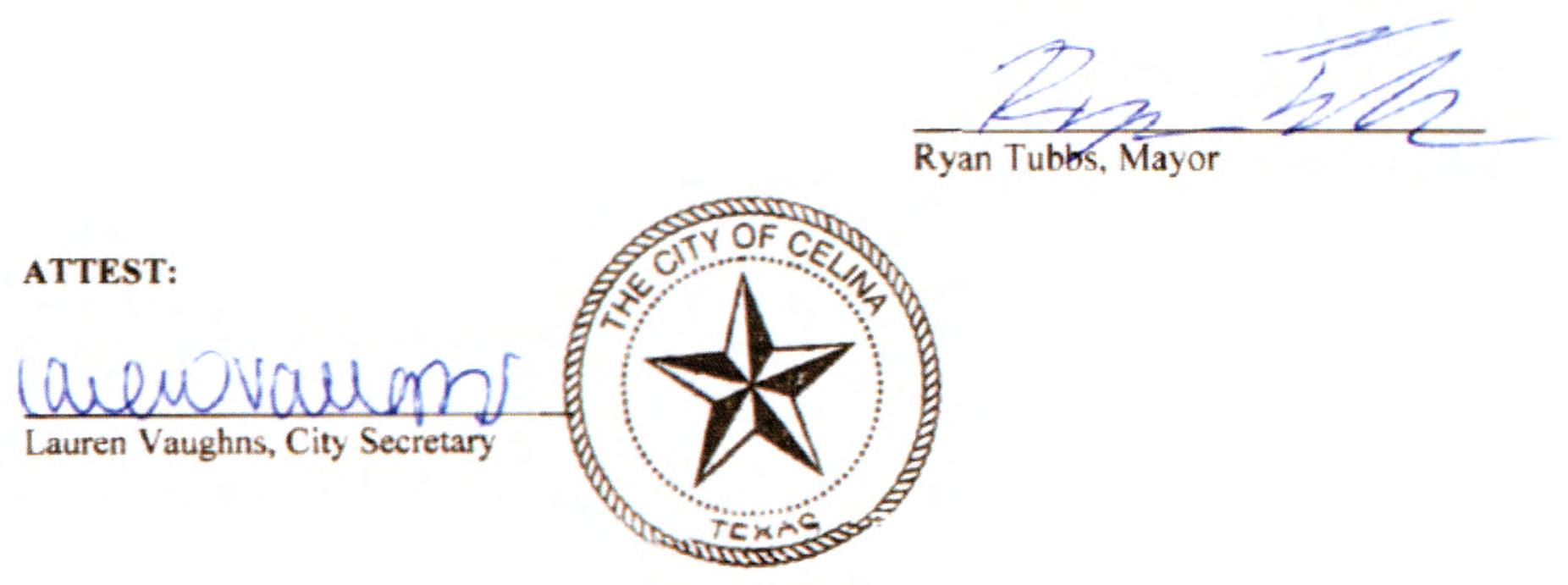
WHEREAS, Local Government Code 102.007 , relating to Adoption of the Budget , requires the City to ratify by a separate vote and provid ing the necessary disclosure language in the ratification, when there is an increase to the property tax revenues in the proposed budget as compared to the previous year; and
WHEREAS , The City's 2023-2024 Budget has an increase in property tax revenues as compared to the previous year; and
WHEREAS , as a result of the approval of the 2023-2024 Budget, the City Council finds that it must ratify the increased revenue from property taxes.
NOW, THEREFORE, BE IT ORDAINED BY THE CITY COUNCIL OF THE CITY OF CELINA, TEXAS, THAT:
Section 1. The increased revenue from property taxes in the 2023 -2024 Budget is hereby ratified, with the following declaration:
Section 2. This Ordinance shall become effective immediately upon its passage.
DULY PASSED and APPROVED, this the 12 th da y of September 2023.
"THIS BUDGET WILL RAISE MORE TOTAL PROPERTY TAXES THAN LAST YEAR'S BUDGET BY $9,535,166 OR 42.00%, AND OF THAT AMOUNT, $5,603,248 IS TAX REVENUE TO BE RAISED FROM NEW PROPERTY ADDED TO THE TAX ROLL THIS YEAR."
